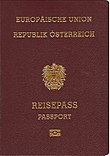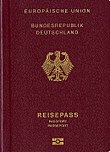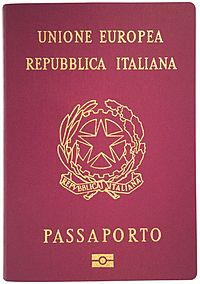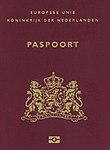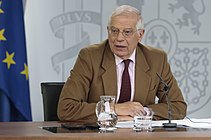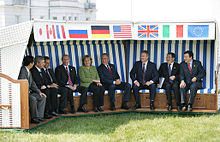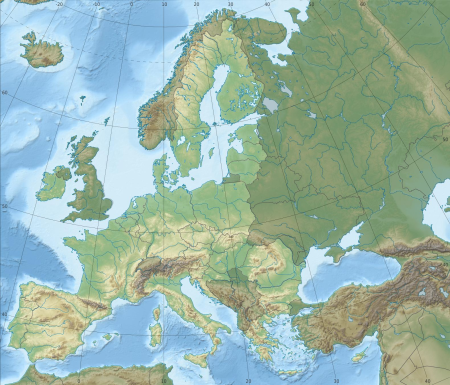European Union
![]()
EU is a redirect to this article. For other meanings of "European Union", "EU", "Eu" and "eu", see EU (disambiguation).
The European Union (EU) is an association of 27 European countries. Outside of geographical Europe, the EU includes Cyprus and some overseas territories. It has a total population of about 450 million. Measured by gross domestic product, the EU internal market is the largest common economic area on earth. The EU is a legal entity in its own right and therefore has the right to see and speak at the United Nations.
The most common languages in the EU are English, German and French. In 2012, the European Union was awarded the Nobel Peace Prize.
The political system of the EU, which has emerged in the course of European integration, is based on the Treaty on European Union and the Treaty on the Functioning of the European Union. It contains both supranational and intergovernmental elements. While the individual states are represented by their governments in the European Council and the Council of the European Union, the European Parliament directly represents the citizens of the Union in EU lawmaking. The European Commission as the executive body and the EU Court of Justice as the judicial body are also supranational institutions.
The beginnings of the EU date back to the 1950s, when initially six states founded the European Economic Community (EEC). Targeted economic integration was intended to prevent military conflicts for the future and, through the larger market, to accelerate economic growth and thus increase the prosperity of citizens. In the course of the following decades, additional states joined the Communities (EC) in several rounds of enlargement. Beginning in 1985, the Schengen Agreement opened internal borders between member countries. After the fall of the Iron Curtain and the dissolution of the Eastern Bloc in 1989, the geopolitical situation in Europe changed fundamentally, opening up opportunities for integration and expansion in the East.
The Treaty of Maastricht established the European Union in 1992, giving it powers in non-economic policy areas. In several reform treaties, most recently the Treaty of Lisbon, the supranational competences of the EU were expanded and the democratic anchoring of political decision-making processes at the Union level was improved, above all by further strengthening the position of the European Parliament. However, a European public sphere and identity as a prerequisite for supranational popular sovereignty is only gradually emerging, and not without countercurrents. Since the 1980s, the EU has been given more powers and has gained in importance. The constitutionality of the EU was debated; EU skepticism was also expressed. In 2007, the Treaty of Lisbon also regulated exit scenarios.
Of the 27 EU states, 19 form an economic and monetary union. In 2002, a common currency for these countries, the euro, was introduced. Within the framework of the area of freedom, security and justice, the EU member states cooperate on domestic and judicial policy. Through the common foreign and security policy, they strive to act together vis-à-vis third countries. Future-oriented joint action is the subject of the Europe 2020 initiative, which includes digital policy. The European Union has observer status in the G7, is a member of the G20 and represents its member states in the World Trade Organization.
In 2016, the EU was the world's second-largest economic area in terms of nominal gross domestic product (behind the USA) and purchasing power-adjusted gross domestic product (behind the People's Republic of China). As an association of states, it is the world's largest producer of goods and the largest trading power. Its member states have some of the highest living standards in the world, although there are significant differences between individual countries even within the EU. In the Human Development Index, 26 of the then 28 member states were considered "very highly" developed in 2015.
After the eastward enlargement in 2004 and 2007, the standard of living and economic growth have risen sharply, especially in Eastern Europe. At the same time, however, as a result of the financial crisis from 2007 and through the refugee crisis from 2015, the European Union has been exposed to increasing EU skepticism from parts of the population in various member states, which has been reflected, among other things, in the withdrawal of Great Britain. Under the impression of the crisis phenomena and the rise of right-wing populist tendencies in the member states of the Union, the EU finality debate is once again being intensively conducted. On the other hand, approval ratings for the EU are currently higher across Europe than they have been for decades. With his Initiative for Europe, French President Emmanuel Macron has presented a reform plan for the near future that has attracted a great deal of attention.
History
→ Main article: History of the European Union
Already after the First World War, there were various efforts to form a union of European states, such as the Paneuropa Union founded in 1922. However, these efforts were ultimately unsuccessful. The decisive starting point for European integration did not come until the end of the Second World War: By networking the militarily relevant economic sectors, a new war between the former adversaries was to be made impossible and, as a consequence, political rapprochement and lasting reconciliation between the states involved was to be achieved. In addition, security policy considerations were also important: In the incipient Cold War, the Western European states were to be brought closer together and the Federal Republic of Germany was to be integrated into the Western bloc.
Timetable
| Subz. | 19481948 | 19511952 | 19541955 | 19571958 | 19651967 | 19861987 | 19921993 | 19971999 | 20012003 | 20072009 |
|
|
|
|
|
|
|
|
| ||
|
|
|
|
|
|
|
|
|
|
| ||||||||||||
| European Communities | Three pillars of the European Union | ||||||||||||||||||||
| European Atomic Energy Community (EURATOM) | → | ← | |||||||||||||||||||
| European Coal and Steel Community (ECSC) | Contract expired in 2002 | European Union (EU) | |||||||||||||||||||
|
|
| European Economic Community (EEC) | European Community (EC) | ||||||||||||||||||
|
|
|
| → | Justice and Home Affairs (JHA) | |||||||||||||||||
|
| Police and judicial cooperation in criminal matters (PJZS) | ← | |||||||||||||||||||
| European Political Cooperation (EPC) | → | Common Foreign and Security Policy (CFSP) | ← | ||||||||||||||||||
| Western Union (WU) | Western European Union (WEU) |
|
| ||||||||||||||||||
| dissolved as of July 1, 2011 | |||||||||||||||||||||
|
|
|
|
|
|
|
|
|
|
|
| |||||||||||
Coal and Steel Union (1951)
→ Main article: Coal and Steel Union
Jean Monnet, then head of the French Planning Office, voiced the proposal to place all Franco-German coal and steel production under a joint authority. French Foreign Minister Robert Schuman took up this idea and presented it to Parliament on May 9, 1950, which is why it went down in history as the Schuman Plan. This Schuman Plan led to the founding of the European Coal and Steel Community (ECSC, colloquially also "Coal and Steel Community") on April 18, 1951 by Belgium, the Federal Republic of Germany, France, Italy, Luxembourg and the Netherlands. The institutions of this ECSC formed the core of what later became the EU: a High Authority with supranational powers (which later became the European Commission), a Council of Ministers as the legislative branch (now the Council of the EU), and a Consultative Assembly (later the European Parliament). However, the competences of the various bodies changed in the course of integration - for example, the Consultative Assembly still had hardly any say, whereas today the European Parliament has equal rights with the Council in areas where the ordinary legislative procedure applies.
Treaties of Rome (1957)
→ Main article: Treaties of Rome
On March 25, 1957, the so-called Treaties of Rome constituted the next step in integration. With these treaties, the same six states founded the European Economic Community (EEC) as well as the European Atomic Energy Community (EAEC and Euratom). The goal of the EEC was to create a common market in which goods, services, capital and labor could move freely. Through Euratom, there was to be a common development for the peaceful use of atomic energy.
The ECSC, EEC and Euratom each initially had their own Commission and Council. However, with the so-called Merger Treaty in 1967, these institutions were merged and now called the institutions of the European Communities (EC).
Alongside the stages of progressive integration, however, there were also setbacks and phases of stagnation. For example, the plan for a European Defense Community (EDC) failed in the French National Assembly in 1954. In the 1960s, Charles de Gaulle, as President of France, put the brakes on the Community's progress with the so-called empty chair policy and with his repeated veto of British accession to the EEC. Then, in the first half of the 1980s, it was British Prime Minister Margaret Thatcher who prevented further progress in integration by calling for a reduction in British contributions. This phase of stagnant integration was also referred to as Eurosclerosis. Nevertheless, isolated declarations continued to promote the idea of European integration during this period, such as the document on European identity adopted on December 14, 1973, in which the nine member states of the European Communities declared their commitment to the "dynamism of European integration" and affirmed the "envisaged transformation of the totality of their relations into a European Union" as a common goal.
It was not until the end of the 1980s that integration regained momentum. With the Single European Act (SEA) in 1987, the EEC under Commission President Jacques Delors developed the plan for a single European market in which all national barriers to Europe-wide trade were to be overcome by January 1, 1993, through an approximation of economic law.
Maastricht Treaty (1992)
→ Main article: Treaty of Maastricht
The fall of the Iron Curtain, the associated loss of power of the communists in the Eastern Bloc together with the change of government system in the GDR, Poland, Hungary, the ČSSR as well as Bulgaria and Romania led to the end of the East-West confrontation and thus to the enabling of the reunification of Germany and to further integration steps: On February 7, 1992, the Maastricht Treaty establishing the European Union (EU) was signed. It entered into force on November 1, 1993. On the one hand, the treaty decided to establish an economic and monetary union, which later led to the introduction of the euro; on the other hand, the member states decided on closer coordination in foreign and security policy and in the area of home affairs and justice. At the same time, the EEC was renamed the European Community (EC), as it was now given responsibilities in policy areas other than the economy (such as environmental policy).
With the Treaty of Amsterdam (signed in 1997) and the Treaty of Nice (in force since February 2003), the EU's treaty structure was again revised to bring about better functioning of the institutions. Until the Lisbon Treaty, only the European Communities had legal personality, not the European Union itself. This meant that the EC could take generally binding decisions within the scope of its competences, while the EU merely acted as an "umbrella organization." In the Common Foreign and Security Policy (CFSP) in particular, the EU could not act as an independent institution, but always only in the form of its individual member states.
The end of the Cold War also brought the overcoming of the political division of Europe into focus for the EU. It had already grown from six to fifteen members through several rounds of enlargement (1973, 1981, 1986, 1995); now the Central and Eastern European countries that had previously belonged to the Eastern bloc were also to become part of the Union. To this end, the EU member states established the so-called Copenhagen accession criteria in 1993, defining freedom, democracy, the rule of law, human rights and fundamental civil liberties as the Union's core values. In 2004 and 2007, the two eastward enlargements finally took place, in which twelve new members were admitted to the EU.
New objectives for the internal development of the European Union were set in 2000 with the Lisbon Strategy, which was intended to take appropriate account of the challenges of globalization and a new, "knowledge-based" economy. The strategic goal for the coming decade was determined to be "to make the Union the most competitive and dynamic knowledge-based economy in the world - capable of sustainable economic growth with more and better jobs and greater social cohesion." In its 2005 "mid-term review," the European Parliament also expressed confidence that the EU's Lisbon Strategy could serve as a model for economic, social and environmental progress in the world, within the framework of the global goal of sustainable development. The successor program to the Lisbon Strategy, Europe 2020, launched ten years later, formulated essentially similar goals.
Lisbon Treaty (2007)
→ Main article: Treaty of Lisbon
However, the enlargement rounds threatened to increasingly restrict the EU's ability to act politically: The first adjustment reforms took place - with the usual difficulties and compromises - in the agricultural sector, in regional structural support and in the modification of the British rebate. With regard to the institutional structure, however, they were only partially successful: The veto possibilities for individual member states could have blocked a large number of decisions. With the introduction of the enhanced cooperation procedure by the Treaties of Amsterdam and Nice, a way was developed to counteract such a blockade of European decision-making processes. Member states willing to integrate could now take deeper steps toward agreement in individual areas, even if the other EU states did not participate: The Schengen Agreement and monetary union served as models for this. However, this concept of a "multi-speed Europe" also met with criticism, as it threatened to divide the EU. Another problem was the efficiency of the European Commission's work: Until 2004, individual member states still had two commissioners, but after the eastward enlargement the number was reduced to one commissioner per country - yet the Commission grew from nine members in 1952 to 27 members in 2007.
At the Laeken Summit in 2001, the EU heads of state and government therefore decided to convene a European Convention to draw up a new basic treaty that would make the EU's decision-making procedures more efficient and at the same time more democratic. In October 2004, this constitutional treaty was signed in Rome. Among other things, it provided for the dissolution of the EC and the transfer of its legal personality to the EU, an expansion of majority decision-making, a reduction in the size of the Commission, and better coordination of the Common Foreign Policy. Ratification of the Constitutional Treaty failed, however, because the French and Dutch rejected it in a referendum. Instead, an intergovernmental conference in 2007 drew up the Treaty of Lisbon, which adopted the main content of the Constitutional Treaty. Ratification was planned by the 2009 European elections, and the Treaty of Lisbon entered into force on December 1, 2009.
In 2012, the European Union was awarded the Nobel Peace Prize "for over six decades of contribution to the promotion of peace and reconciliation, democracy and human rights in Europe."
Phase of the challenges of the Union
Since the financial crisis from 2007 onward, which resulted in high levels of sovereign debt in some cases, and the ensuing euro crisis, the European Union has experienced economic and social turmoil among some of its members, which has in some cases strained the relationship between member states in need of financial assistance and those eligible for support measures. After 2010, a number of measures were initiated to address the euro crisis, including the European Stability Mechanism (ESM), established in 2012 as part of the euro bailout fund, and the European Fiscal Compact, which imposes fiscal discipline and debt limits on participating member states. The European Banking Union has transferred national competencies to central institutions as of 2014, creating uniform, common guidelines and regulations in the area of financial market supervision and the recovery or resolution of credit institutions within the European Union. Also, with the strengthening and sustained economic growth now of all member states after 2016, the European Union has begun to slowly overcome this crisis. Further institutional reforms such as a coordinated economic and social policy or the further development of the ESM into a European Monetary Fund are on the agenda of the EU in order to better and more quickly manage future crises or to prevent them from arising in the first place.
Disunity and further crisis-ridden developments in the European Union resulted in the refugee crisis from 2015 onward. In this overall context, anti-European political currents received further impetus. The refugee crisis is also seen as partly responsible for the United Kingdom's exit from the European Union. The willingness of the various governments of the member states to accept refugees varied greatly and stood in the way of joint action by the members of the Union to overcome the crisis, which was easily manageable for the Union as a whole. In some cases, border controls were reintroduced in the Schengen area; on the other hand, various arrangements were made to protect the EU's external borders, including the expansion of Frontex. A plan for the distribution of refugees among the member states was only rudimentarily implemented and was boycotted by national conservative governments, in part openly, contrary to majority decisions confirmed by the European Court of Justice. It is not only in this context that the European Union will soon have to decide what means it should use in the future to respond to open breaches of treaty by these governments, because the Treaty on European Union obliges the Member States of the European Union to show solidarity and uphold the rule of law (cf. Art. 2 TEU, Art. 3 TEU).
Global warming and bringing about effective climate protection are seen as a priority challenge for political action by the EU's newly elected institutions in 2019. On the occasion of the confirmation of the newly composed EU Commission by the European Parliament, President-elect Ursula von der Leyen issued the goal of reducing greenhouse gas emissions in the EU by 50 percent by 2030, rather than 40 percent as previously planned, as part of a "European green deal." Europe was to become the first climate-neutral continent. On the following day, November 28, 2019, the European Parliament declared a climate emergency for Europe. As a consequence, the European Commission is to align all its policies with the global goal of limiting global warming to 1.5 degrees compared to pre-industrial times.
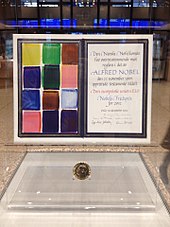
The certificate of the Nobel Peace Prize

Celebrations after the awarding of the Nobel Peace Prize to the EU in 2012.
_edited.jpg)
The signatories of the Lisbon Treaty in 2007
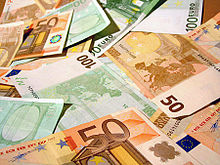
The introduction of the euro as a standard currency in 1999, since 2015, the eurozone includes 19 member states.

The Treaty of Maastricht in 1992 establishes the European Union. (Place of signature)
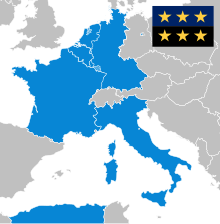
The six founding members of the ECSC in 1951 (Algeria was still part of France)

Hall and conference venue where the Treaties of Rome were signed in 1957
Political system
→ Main article: Political system of the European Union
The political system of the European Union clearly differs from national political systems. As a supranational association of sovereign states, the EU has its own sovereign rights, unlike a confederation of states; on the other hand, the EU institutions do not have competence competence - so unlike a federal state, the EU cannot shape the distribution of competences within its system itself. In accordance with the principle of conferral, the EU institutions may only act in those areas that are explicitly mentioned in the founding treaties. In its 1993 Maastricht ruling, the German Constitutional Court therefore coined the new term "association of states" to characterize the EU in terms of constitutional law.
The two most important treaties on which the EU is currently based are the Treaty on European Union and the Treaty on the Functioning of the European Union (TFEU; formerly the EC Treaty). They are therefore referred to as European primary law. All secondary law, which the EU itself enacts according to its own legislative procedures, is derived from these treaties and the competences mentioned therein. However, as a result of the legal personality that the EU has had since December 1, 2009, it can sign international treaties and agreements in its own name as a subject of international law (albeit in principle only by unanimous decision of the Foreign Affairs Council). Through the newly created European External Action Service, it can establish diplomatic relations with other states and apply for membership in international organizations - such as the Council of Europe or the United Nations.
In addition to the EU, there is also the European Atomic Energy Community (Euratom), which is based on its own founding treaty concluded in 1958 (the Euratom Treaty). Following the dissolution of the ECSC and EC, Euratom is the last of the remaining European Communities. In its structures, however, it is fully affiliated with the EU and also shares its institutions with it.
Law
→ Main article: European law and legislation of the European Union
Depending on the policy area, the EU has different competences and voting procedures. In principle, legal acts adopted by the European institutions - Commission, Council and Parliament - in accordance with the EU's legislative procedures are binding. Since the governments of individual states can also be outvoted here, this is referred to as the supranational (supranational) community method. In some policy areas, such as trade policy, the vote is unanimous, but the decisions are binding and cannot be revoked by the individual states.
Other areas in which the EU has no legislative competence are characterized by purely intergovernmental (intergovernmental) decision-making mechanisms. This applies above all to the Common Foreign and Security Policy (CFSP): Here, it is a matter of mere cooperation between the governments of the member states, whereby all decisions must be taken unanimously and also do not have immediate legal force.
Finally, the third method alongside the Community and intergovernmental methods is the open method of coordination, which is used in some areas for which the EU has no legislative competence of its own. Here, no formal decisions are taken, but only informal coordination of the member states in the Council; the Commission only acts in a supporting role.
The EU's supranational policy areas include, among others, the customs union, the European Single Market, the European Economic and Monetary Union, research and environmental policy, health care, consumer protection, areas of social policy, and the area of freedom, security and justice. The latter covers aspects of home affairs and justice policy, including immigration policy, judicial cooperation in civil matters, and police and judicial cooperation in criminal matters.
The supranational competences of the EU in this core area are evident in several ways:
- The Council of the European Union usually decides on the basis of the majority principle. The veto options of the individual member states are severely limited; in most policy areas, they can be outvoted by a qualified majority.
- The supranational European Parliament has full legislative rights in most policy areas. The governments of the member states cannot therefore legislate against the will of the Parliament.
- Certain executive activities in the EU are left entirely to the European Commission. This makes its independence vis-à-vis national governments particularly clear.
- EU law has a high binding effect: EU regulations are directly applicable law in all member states; in the case of EU directives, the member states are obliged to transpose them into the respective national law (even if the exact form is left to the individual states). The jurisdiction of the courts of the European Union with the European Court of Justice (ECJ) at its head is mandatory.
The European Commission (sole right of initiative), the Council of the European Union and the European Parliament are involved in the creation of EU legal acts in accordance with the ordinary legislative procedure. A distinction is made between EU regulations (directly valid in the member states without a national act of transposition), EU directives (binding only after transposition into national law) and EU decisions (in each case a legal act in the individual case, similar to an administrative act).
Institutions
The institutional structure of the EU has remained essentially constant since its beginnings in 1952, although the competences of the individual institutions have changed several times. The legal basis for the institutions is Title III of the EU Treaty and Part Six of the TFEU.
In many respects, the EU displays typical features of a federal system, with the Commission as the executive and a two-part legislature consisting of the European Parliament as the chamber of citizens and the Council as the chamber of states. The important role of the Council is based on the concept of executive federalism, which also characterizes the Federal Republic of Germany. Compared with the practices in federal nation states, however, the influence of the lower level (in this case, the governments of the member states) is greater in the EU: For example, the members of the Commission are proposed by the national governments and the national parliaments are closely involved in EU policy through their EU committees. Another special feature is the European Council, the summit of heads of state and government that takes place every three months. According to the EU Treaty, this institution is to set the general political guidelines of the Union. It thus has a very great influence on the development of the Union, although it is not formally involved in its legislative process.
The central EU institutions:
|
European Parliament Legislature (Civic Chamber) |
European Council Sets guidelines and impulses |
Council of the European Union Legislature (chamber of states) |
European Commission Executive | |||
|
| ||||||
|
|
|
|
|
|
|
|
|
|
Court of Justice of the European Union Judiciary |
European Court of Auditors Independent control body: Court of Audit |
European Central Bank Central Bank |
| ||
|
|
|
| ||||
|
|
|
European Council
→ Main article: European Council
The European Council (Art. 15 TEU and Art. 235 f. TFEU) is composed of the Heads of State or Government of the Member States and the President of the European Commission, with the President of the Commission acting only in an advisory capacity. It is chaired by the President of the European Council, who is appointed for a term of two and a half years. The European Council sets guidelines and objectives for European policy, but is not involved in day-to-day procedures. Votes in the European Council are generally taken "by consensus," that is, unanimously; only certain operational decisions are taken by majority vote. The European Council meets at least four times a year and generally convenes in Brussels.
Council of the European Union
→ Main article: Council of the European Union
The Council of the European Union (Art. 16 TEU and Art. 237 et seq. TFEU, also called the Council of Ministers) is one of the two legislative bodies of the EU and represents the member states (Länderkammer). Depending on the policy area, it is composed of the respective ministers of the national governments of the Member States and adopts the decisive legal acts together with the European Parliament. Depending on the policy field, either a unanimous decision or a qualified majority is required for this, whereby the principle of double majority (of states and inhabitants) applies for majority decisions. In intergovernmental areas, especially the Common Foreign and Security Policy and certain fields of trade and social policy, the Council is the EU's only decision-making body; here, decisions are generally taken unanimously.
The presidency of the Council rotates among the member states every six months, with three successive states working together in a so-called trio presidency. An exception is the Foreign Affairs Council, which is chaired by the EU High Representative for Foreign Affairs and Security Policy. The respective Council Presidency is supported by the General Secretariat of the Council of the European Union.
European Parliament
→ Main article: European Parliament
The European Parliament (EP, Art. 14 TEU and Art. 223 et seq. TFEU) is the second part of the EU legislature. In addition to its legislative function, it participates in the adoption of the budget and exercises parliamentary control rights. It has been directly elected by the citizens of the member states every five years in the European elections since 1979 and therefore represents the European population.
After the 2009 European election, the European Parliament initially had 736 members; as of December 2011, it was expanded to 754 (as of the 2014 European election: 751) members in accordance with the Treaty of Lisbon. These are not grouped according to national origin, but along their political orientation in (currently seven) political groups. For this purpose, national parties with similar world views have joined together to form European parties. The strongest group in the European Parliament is currently the Christian Democratic Conservative Group of the European People's Party (EPP/PPE) with 177 MEPs, followed by the Social Democratic Group Progressive Alliance of Socialists and Democrats in the European Parliament (S&D) with 146 MEPs (as of June 23, 2021).
However, the European elections will continue to be held on a national basis. The number of representatives per country is generally based on the size of the population; however, smaller countries are disproportionately represented in order to give them adequate representation of their national party landscape.
The European Parliament has two meeting places, one in Brussels and a second in Strasbourg. It is chaired by the President of the European Parliament (since 2019, the Italian David Sassoli, PES) and his deputies, the fourteen Vice-Presidents. Together they form the Bureau.
European Commission
→ Main article: European Commission
The European Commission (Art. 17 TEU and Art. 244 et seq. TFEU) has primarily executive functions in the institutional structure of the European Union and thus corresponds to the "government" of the EU. However, it is also involved in the legislative process: It has almost the sole right of initiative in EU lawmaking and accordingly proposes legal acts (directives, regulations, decisions). Parliament and the Council, however, are free to amend these proposals afterwards.
As an executive body, the Commission ensures the correct execution of European legal acts, the implementation of the budget and the adopted programs. As the "guardian of the treaties," it monitors compliance with European law and, if necessary, brings actions before the courts of the European Union. At the international level, it negotiates international agreements, especially in the areas of trade and cooperation, and represents the EU in the World Trade Organization, for example.
The European Commission consists of 28 commissioners, one from each member state. The European Council appoints them for five years by qualified majority. However, the European Parliament has a right of approval: it can reject the Commission-designate as a whole (but not individual Commissioners) and can also force it to resign after it has been appointed by means of a vote of no confidence. In this case, the European Council must propose a new Commission.
According to their treaty mandate, the Commissioners serve the Union alone and may not take any instructions. The Commission is therefore a supranational body of the EU, independent of the Member States. Within the Commission, each Commissioner assumes responsibility for a policy area, similar to the ministers in the cabinet of a national government. The political leadership of the Commission lies with the Commission President; from 2014 to 2019 this was Jean-Claude Juncker from Luxembourg, since then it has been Ursula von der Leyen.
The Commission has its own administrative apparatus, divided into departmental directorates-general, which, however, with approximately 23,000 civil servants, is significantly smaller than that of national governments. In addition, there are a number of European agencies that perform specialized tasks. As part of the executive branch, they are attached to the Commission, but functionally independent of it.
A special function is performed by the High Representative of the EU for Foreign Affairs and Security Policy (Art. 18 TEU), who is both a member of the European Commission and Chairman of the Foreign Affairs Council.
Following the 2019 European elections, Ursula von der Leyen was elected as the new President of the Commission, taking office together with her Commission, consisting of a coalition of EPP, S&D and RE, on December 1, 2019.
For the first time, this Commission has three so-called executive vice presidents and five other vice presidents. All vice presidents are responsible for a thematic focus of the von der Leyen Commission's political agenda in addition to their work as commissioners.
| Commission von der Leyen: | ||||||||||
| President | ||||||||||
| Office | Image | Name | Member State | national party | European Party | Group in the EU Parliament | Assigned Directorates General | |||
| President |
| Ursula von der Leyen | Germany | CDU | EVP | EVP | SG, SJ, COMM, EPSC | |||
| Executive Vice Presidents | ||||||||||
| Department | Image | Name | Member State | national party | European Party | Group in the EU Parliament | Assigned Directorates General | |||
| European Green Deal |
| Frans Timmermans | Netherlands | PvdA | SPE | S&D | CLIMA | |||
| Europe fit for the digital age (incl. competition) |
| Margrethe Vestager | Denmark Denmark | RV | ALDE | RE | COMP | |||
| Economy for the people |
| Valdis Dombrovskis | Latvia | Vienotība | EVP | EVP | FISMA | |||
| Vice Presidents | ||||||||||
| Department | Image | Name | Member State | national party | European Party | Group in the EU Parliament | DGs | |||
| Strengthening Europe in the world (EU High Representative for Foreign Affairs and Security Policy) |
| Josep Borrell | Spain | PSC | SPE | S&D | EEAS, FPI | |||
| Values and transparency |
| Věra Jourová | Czech Republic Czech Republic | ANO 2011 | ALDE | RE | ||||
| Promotion of the European way of life |
| Margaritis Schinas | Greece | ND | EVP | EVP | ||||
| Interinstitutional relations and foresight |
| Maroš Šefčovič | Slovakia | SMER | SPE | S&D | JRC | |||
| New momentum for European democracy |
| Dubravka Šuica | Croatia | HDZ | EVP | EVP | COMM | |||
| Other commissioners | ||||||||||
| Department | Image | Name | Member State | national party | European Party | Group in the European Parliament | Assigned Directorates General | |||
| Budget and administration |
| John Rooster | Austria | ÖVP | EVP | EVP | BUDG, HR, DGT, DIGIT, SCIC, OIB, OIL, PMO, OP, OLAF | |||
| Justice and the rule of law |
| Didier Reynders | Belgium | MR | ALDE | RE | JUST, IAT | |||
| Innovation and youth |
| Marija Gabriel | Bulgaria | GERB | EVP | EVP | RTD, EAC, JRC | |||
| Health |
| Stella Kyriakides | Cyprus Republic of | DISY | EVP | EVP | SANTE | |||
| Energy |
| Kadri Simson | Estonia | K | ALDE | RE | ENER | |||
| International partnerships |
| Jutta Urpilainen | Finland | SDP | SPE | S&D | DEVCO | |||
| Internal Market (incl. defense and space) |
| Thierry Breton | France | non-partisan | CNECT, GROW, new DG for defense | |||||
| Neighborhood and extension |
| Olivér Várhelyi | Hungary | Fidesz | EVP | EVP | NEAR | |||
| Trade |
| Phil Hogan | Ireland | FG | EVP | EVP | TRADE | |||
| Economy (incl. taxes and customs union) |
| Paolo Gentiloni | Italy | PD | SPE | S&D | ECFIN, TAXUD, ESTAT | |||
| Environment and oceans |
| Virginijus Sinkevičius | Lithuania | LVŽS | non-partisan | G/EFA | ENV, MARE | |||
| Jobs |
| Nicolas Schmit | Luxembourg | LSAP | SPE | S&D | EMPL | |||
| Equality |
| Helena Dalli | Malta | MLP | SPE | S&D | JUST, new task force for equality | |||
| Agriculture |
| Janusz Wojciechowski | Poland | PiS | EKR | EKR | AGRI | |||
| Cohesion and reforms |
| Elisa Ferreira | Portugal | PS | SPE | S&D | REGIO, new DG for structural reforms | |||
| Traffic |
| Adina Vălean | Romania | PNL | EVP | EVP | MOVE | |||
| Crisis management |
| Janez Lenarčič | Slovenia | non-partisan | ECHO | |||||
| Inner |
| Ylva Johansson | Sweden | SAP | SPE | S&D | HOME | |||
| ||||||||||
European Central Bank
→ Main article: European Central Bank
The European Central Bank (ECB, Art. 282 et seq. TFEU) has determined monetary policy in the euro area countries since January 1, 1999. The bank is politically independent: Its Executive Board is appointed by the European Council; however, it is not subject to political directives, but only to the monetary policy objectives laid down in the TFEU - in particular, the maintenance of price stability. An important steering instrument for this purpose is the setting of key interest rates. Together with the national central banks, the European Central Bank forms the European System of Central Banks (ESCB).
Court of Justice of the European Union
→ Main article: Court of Justice of the European Union
The Court of Justice of the European Union is the name given to the entire judicial system of the European Union (Art. 19 TEU and Art. 251 et seq. TFEU). The European Court of Justice (ECJ, officially just Court of Justice) is the supreme court of the European Union. In addition to the European Court of Justice, the European Court of First Instance (originally the European Court of First Instance) has existed since 1989. Both instances consist of at least one judge per Member State, with the ECJ additionally assisted by at least eight Advocates General (Art. 252). These are appointed by the governments of the Member States by consensus for a period of six years. Every three years, both instances are partially renewed. Since the Treaty of Nice, it has been possible to create independent specialized courts below the European Court.
The Court of Justice of the European Union is intended to ensure uniform interpretation of European Union law. It is empowered to rule itself in certain cases on legal disputes between EU member states, EU institutions, companies and private individuals. The progress of the European integration process has been promoted in part independently by the judgments of the ECJ, which has made the Community law for whose interpretation it is responsible directly applicable in the individual member states.
European Court of Auditors
→ Main article: European Court of Auditors
The European Court of Auditors (ECA, Art. 285 et seq. TFEU) was created in 1975 and is responsible for auditing all the Union's revenue and expenditure and for checking the legality of its financial management.
The European Court of Auditors currently has 27 members, one from each Member State, appointed by the Council of the European Union for six years. The ECA's current staff of about 800 form audit teams for specific audit projects. They can make audit visits at any time to other institutions, to Member States, and to other countries receiving EU aid. However, the ECA cannot impose legal sanctions. Violations are reported to the other institutions so that appropriate action can be taken.
The ECA's work reached wide publicity in 1998 and 1999, when it denied the European Commission a Statement of Assurance. However, the subsequent resignation of the Santer Commission should not be understood as an immediate reaction to the Court of Auditors' report; since the Court of Auditors has been issuing statements of assurance (since the early 1990s), they have always been negative.
Other facilities
The Committee of the Regions (CoR), based in Brussels, has represented regional and local authorities in the EU since its establishment in 1992. It has an advisory role in the legislative process and must be consulted in particular before decisions are taken that affect regional and local government. Of the 344 members of the CoR, 24 come from Germany, of which 21 are proposed by the federal states and three by the municipalities. Austria provides twelve members, nine of them representatives of the federal states and three of the municipalities.
The European Economic and Social Committee (EESC) is a body that has existed since 1957. It is supposed to represent "organized citizenship" (on the model of the French Economic and Social Council); its 344 members are composed of one-third each of employers' and trade union representatives and representatives of other interests (such as agriculture, environmental protection, etc.). They are appointed by the governments of the member states, but are not accountable to them. Like the CoR, the EESC acts only in an advisory capacity, but must be consulted on all matters of economic and social policy.
The European Ombudsman, based in Strasbourg, is the Ombudsman of the European Union and has been investigating complaints about maladministration in its institutions, bodies, offices and agencies since 1992.
The European Data Protection Supervisor (EDPS) is an independent supervisory authority of the European Union, established on the basis of Regulation (EC) No. 45/2001 (Data Protection Regulation) to provide data protection advice and supervision to the EC institutions and bodies. It is based in Brussels and has been a member of the International Conference of Data Protection and Privacy Commissioners since 2004.
The European Investment Bank (EIB; Art. 308 et seq. TFEU), headquartered in Luxembourg, was established in 1958. The bank is also politically independent and finances itself by borrowing on the capital markets. The EIB supports the Member States and smaller companies by granting loans to finance projects that are in the European interest, such as infrastructure projects or environmental protection measures.
The INTCEN, based in Brussels, is not an official body of the EU, but has recently been seen in some quarters as the nucleus of a cross-EU intelligence service.
Citizenship of the Union
→ Main article: Citizenship of the Union
Citizenship of the European Union is held by all nationals of a Member State of the European Union according to Article 20 of the Treaty on the Functioning of the European Union (TFEU). From the citizenship of the Union follows a number of rights of citizens of the Union, especially in the other Member States of which they are not nationals.
Rights include, in particular: Freedom of movement, prohibition of discrimination, right to vote in local elections in the place of residence, right to vote for the European Parliament, diplomatic and consular protection, right to petition and complain, and the right to communicate with the EU in one of the official languages of the European Union and to receive a reply in the same language. The Lisbon Treaty also introduced an instrument of direct democracy for the first time in the form of the European Citizens' Initiative.
Budget
→ Main article: Budget of the European Union
In the budget of the European Union, the revenues and expenditures are determined annually for the following EU budget year. The budget is integrated into a system of a so-called multi-year financial framework (MFF) that has been in place since the Treaty of Lisbon came into force on December 1, 2009. The European Union sets the binding financial framework for the budget in a multi-year period. It is agreed on the basis of a proposal by the European Commission by the Council, which in this case decides unanimously, together with the European Parliament, and transferred into a so-called interinstitutional agreement.
To finance its expenditures, the European Union has so-called own resources, which consist of contributions from the member states and, to a lesser extent, import duties at the external borders. The contributions of the member states result, on the one hand, from a share of the sales tax that must be paid to the EU (so-called VAT own resources) and, on the other hand, from contributions that are proportional to the gross national income (GNI) of the states. The so-called British rebate was an exception to this: Since a very large share of EU funds is spent on the Common Agricultural Policy, from which the United Kingdom benefited only slightly due to its comparatively small agricultural sector, it has been refunded two-thirds of its net contributions since 1984.
The EU budget and the level of contributions to be paid by the member states are the subject of many disputes and compromises, especially since the return flows of EU financial resources to the individual member states vary. In the European Council, therefore, the camps of net contributor and net recipient states are opposed to each other: While the net recipients mostly strive to maintain their status, the net payers try to at least reduce their payments.
Equally controversial is the expenditure side of the budget, although around 90% of this flows back to the member states. Within the framework of regional structural support, the EU strives to equalize the level of living in its member states. The flow of funds to the 271 regions into which the territory of the EU is divided (so-called NUTS 2 level) is based on per capita gross domestic product (GDP); the 99 regions in which GDP is below 75 % of the EU average from 2000 to 2002 receive higher allocations. However, because the rest of the budget is spent on a policy-area basis and not on a country-by-country basis, the net ratio of EU funds does not necessarily depend on a country's GDP: Ireland, for example, was a net recipient until 2009, despite having the second-highest average income in the EU after Luxembourg. Subsidies under the Common Agricultural Policy account for a large share of this policy area-specific spending.
The Multiannual Financial Framework as a financial planning instrument is drawn up for seven years at a time. The budgetary resources earmarked therein for the years 2007-2013 amount to around 975 billion euros, corresponding to 1.24% of the gross national income of all member states. This amount corresponds to the permissible ceiling set by the Council of the EU in the so-called Own Resources Decision. Within the financial framework, an annual budget is established with the Parliament and the Council acting jointly as the EU's budgetary authority: Both institutions can make amendments to the preliminary draft budget proposed by the Commission, with the Council having the final say on revenue and the Parliament on expenditure.
| Multi-year financial framework in € million | ||||
| Category | 2007–2013 | 2014–2020 | Comparison absolute | Comparison in % |
| 1. sustainable growth | 446.310 | 450.763 | +4.453 | +1,0 % |
| 1a. Competitiveness for growth and employment | 91.495 | 125.614 | +34.119 | +37,3 % |
| 1b. Cohesion for growth and employment | 354.815 | 325.149 | −29.666 | −8,4 % |
| 2. preservation and management of natural resources | 420.682 | 373.179 | −47.503 | −11,3 % |
| of which market-related expenses and direct payments | 336.685 | 277.851 | −58.834 | −17,5 % |
| 3. citizenship, freedom, security and justice | 12.366 | 15.686 | +3.320 | +26,8 % |
| 4. the EU as a global partner | 56.815 | 58.704 | +1.899 | +3,3 % |
| 5. management | 57.082 | 61.629 | +4.547 | +8,0 % |
| 6. compensation payments | - – | 27 | +27 | +100 % |
| Total commitment appropriations | 994.176 | 959.988 | −34.188 | −3,5 % |
| Commitment appropriations as a percentage of GNI | 1,12 % | 1,00 % | ||
In the Multiannual Financial Framework for the years 2014-2020, 39 percent of the total funds are earmarked for the Common Agricultural Policy; 34% is allocated to EU structural policy, 13% to research and technology, 6% each to foreign policy and administration; 2% is set aside for the fields of European citizenship, freedom, security and justice. The European Council reached a political agreement in February 2013 that the expenditure ceiling for the European Union for the period 2014-2020 is 959,988 million euros in commitment appropriations. This corresponds to 1.00% of the EU's gross national income.
.jpg)
Commission PresidentUrsula von der Leyen

Political system of the European Union: the seven institutions of the EU in dark blue.
.jpg)
President of the European CouncilCharles Michel
.jpg)
President of the European Central BankChristine Lagarde

The EESC is based in Brussels
Common passport design of the EU members
Burgundy red, Member State name and coat of arms, European Union title and biometric passport symbol

Expenditure shares in the 2007-13 MFF: Sustainable growth Natural resources Citizenship, Freedom, Security, Justice The EU as a global partner Management Compensation payments

Origin of EU revenues (2011): Traditional own funds: 13 % Value added tax own resources: 11 GNI own resources: 75 Other income: 1%
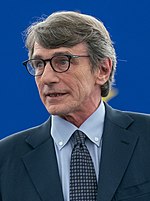
Parliament PresidentDavid Sassoli
Policies
All competences not conferred on the European Union in the Treaties remain with the Member States in accordance with Article 5 TEU. According to the principle of conferral, the Union shall act only within the limits of the competences conferred upon it by the Member States in the Treaties to attain the objectives set out therein. In accordance with the principle of subsidiarity, the Union shall take action in areas which do not fall within its exclusive competence only if and insofar as the objectives pursued can be better achieved at Union level than by the Member States. At the same time, EU action may not go further than is necessary to achieve the objectives set out in the EU Treaty (principle of proportionality). Despite these restrictive principles, EU legislation also determines a large part of national legislation: In the Federal Republic of Germany, for example, two-thirds of all laws passed in the area of domestic policy can be traced back to initiatives or legal acts at the EU level.
The Treaties confer on the Union either exclusive competence in a given area, or competence shared with the Member States. In certain areas, the Union also has competence only to implement measures to support and coordinate the actions of the Member States (supporting competence). According to Art. 3 TFEU, the Union has exclusive competence in the areas of the European Customs Union, the definition of competition rules for the European Single Market, the monetary policy of the states participating in the European Monetary Union, the conservation of marine biological resources under the Common Fisheries Policy, and the Common Commercial Policy. The shared competences according to Art. 4 TFEU include the European internal market, certain areas of social policy, economic, social and territorial cohesion, agriculture and fisheries with the exception of the conservation of marine biological resources, environmental policy, consumer protection, transport policy, trans-European networks, energy policy, the area of freedom, security and justice, certain areas of health protection, research, technology and space policy, and development policy.
![]()
Policy areas of the European Union
Responsibilities under the EU Treaty: Common Foreign and Security Policy | Common Security and Defense Policy. Competences under TFEU: Internal Market | Customs Union | Capital Markets Union | Agricultural and Fisheries Policy | Area of Freedom, Security and Justice (includes policies on border controls, asylum and immigration, judicial cooperation in civil matters, judicial cooperation in criminal matters, police cooperation) | transport policy | competition policy | approximation of laws | economic and monetary union | employment policy | social policy | education policy | sports policy | cultural policy | gender equality policy | health policy | consumer protection policy | trans-European networks | industrial policy | regional policy | research policy | environmental policy | energy policy | tourism policy | humanitarian aid and civil protection | administrative cooperation | trade policy | development policy.
See also: Political System of the European Union, Treaty on European Union, and Treaty on the Functioning of the European Union.
Economic policy
The history of European unification is characterized by the overriding importance of economic integration steps. Initiated by the communitarization of the coal and steel sector in 1952 and continued with the creation of the EEC and EURATOM in 1957 and the completion of the single market in 1993, they led up to the introduction of the euro as cash in 2002.
Today, the institutions of the EU play an important role in European economic policy in several areas: While the agricultural sector is characterized by an EU-wide market organization with high subsidies, the influence of the Union in industry and trade is particularly evident in the specification of standards and competition rules, compliance with which is monitored by the Commission. The main competence for ensuring fair competition on the internal market lies with the Competition Commissioner of the European Commission, who complements the respective antitrust authorities of the individual states as a supranational body. In addition to controlling the economy, he is also responsible for approving subsidies in the member states. This is intended to prevent individual states from supporting national companies to the detriment of competitors from the rest of the EU.
To strengthen European industry, the EU promotes new technologies. For example, numerous coordination bodies have been set up to develop uniform standards so that the internal market is not hampered in its development by differing technical standards.
In addition, the EU promotes, among other things, the cooperation of small and medium-sized enterprises in particular in the research and development of innovative products for growth markets. Externally, too, the EU countries act as a unified economic bloc and are represented by the Trade Commissioner in the World Trade Organization, for example.
Customs union and internal market
→ Main article: European Customs Union and European Single Market
The 1957 EEC Treaty aimed to remove barriers to trade between the Member States and provided for the gradual introduction of the so-called four fundamental freedoms, namely the free movement of goods, capital, services and labor within the territory of the Community. Of particular importance is the free movement of goods (Art. 28 et seq. TFEU), which prohibits import and export duties as well as quantitative import and export restrictions (quotas) within the internal market. Since the 1980s, the fundamental freedoms have been extended - inter alia by the case law of the ECJ and by the Single European Act - so that all other national standards that impede interstate trade within the Community are also prohibited. The economic community was thus expanded into a single internal market.
Since 1968, a customs union has been in force within the European Union, which means that trade between different member states may not be hindered by customs duties or levies having the same effect. In addition, the member states have a common customs tariff vis-à-vis third countries. Turkey has also been a member of the customs union since 1996, as have Andorra and San Marino. The EEA member states Iceland, Liechtenstein and Norway form a free trade area with the customs union, but do not apply the common customs tariff vis-à-vis third countries.
Furthermore, Art. 34 et seq. TFEU generally prohibit quantitative restrictions on imports and exports between EU member states. Such restrictions are only permissible if such national legislation is necessary to protect public safety and order, for reasons of morality and public health, for reasons of the protection of human, animal and plant life or for the preservation of national treasures of artistic, historical or archaeological value or for the protection of industrial property. A general prohibition of discrimination also applies throughout the EU, according to which no EU citizen may be discriminated against on the basis of his or her citizenship. With regard to this so-called equal treatment of nationals, for example, merchants who sell goods in another EU member state may not be subject to any regulations other than those applicable to nationals of the state in question.
The case law of the European Court of Justice on the free movement of goods has made this fundamental freedom the driving force behind further market integration. The free movement of goods has been significantly expanded by the fact that goods-related regulations of the member states that treat EU foreigners in the same way as nationals and do not provide for quotas are also considered impermissible if they actually make trade in goods between the member states more difficult. According to the ECJ, such provisions have the same effect as quotas and are therefore equally contrary to the Treaty. This also applies to provisions that apply equally to nationals and foreigners: For example, the regulation has fallen according to which only beer brewed according to the German Purity Law could be sold in Germany. Since the purity law applied to both German and foreign producers, it was not disadvantageous, but it was practically tantamount to a ban on imports into Germany for beers produced outside Germany. However, national regulations that inhibit trade are permitted in cases where quantitative import and export restrictions would also be allowed. Furthermore, such regulations are permissible if they are not product-related but distribution-related.
With the Single European Act in 1986, the goal of a common internal market was also enshrined in the treaty. To prevent the principle whereby products that can be manufactured and sold in one EU member state cannot be banned throughout the rest of the Union from leading to a race to undercut production standards, the member states harmonized many of their legal and administrative regulations and created a large number of EU-wide standards in the Council of the European Union - despite criticism of the centralization this would entail.
Competition policy
In order to prevent economic cartels and monopolies in the EU and to ensure fair competition on the internal market, the antitrust authorities of the individual states are supported by the Competition Commissioner of the European Commission. In addition to controlling the economy, he is also responsible for approving subsidies in the member states. This is to prevent individual states from supporting certain companies in an anti-competitive manner. Subsidies are only permitted for economically weak regions (such as eastern Germany).
EU competition policy (Articles 101 et seq. TFEU) has played a major role in forcing many monopoly-like companies, for example in the telecommunications sector, in gas, water and electricity supply and in rail transport, to give up their special position and face competition from other providers on the market. The pressure of competition often led to spurts of innovation and to falling consumer prices, but also to changes in wage and working conditions and, in many cases, to job cuts at the companies concerned. Liberalization was and is therefore viewed critically in parts of the public.
Free movement of services
While the reduction of barriers to trade in goods progressed quite rapidly after the establishment of the common internal market, barriers to interstate trade remained in the services sector (Art. 56 et seq. TFEU) for some time. This problem area was addressed by the European Services Directive of December 12, 2006, which is considered by the European Commission to be an important component of the Lisbon Strategy for promoting the European economy. As a directive, it requires transposition into national law by the individual member states.
The aim of the directive is to promote cross-border trade in services. To this end, it provides for certain facilitations for established service providers, including the creation of single points of contact and electronic processing. Its scope covers not only traditional service providers such as hairdressers, IT specialists, service providers in the construction industry and craftsmen, but also in part services of general interest such as care for the elderly, childcare, facilities for the disabled, home education, waste collection, transport systems, etc., insofar as these are already provided under market conditions in the Member State concerned.
European Economic and Monetary Union
→ Main article: European Economic and Monetary Union
The introduction of a common European currency (Art. 127 et seq. TFEU) was a topic of discussion in the European Economic Community at an early stage. After initial attempts in this direction, such as the Werner Plan of 1970, failed, the euro was finally introduced as a common currency on the basis of the Maastricht Treaty: in 1999 for central and commercial banks, and in 2002 as a means of cash payment in all participating member states.
However, not all EU member states are members of the monetary union. During the negotiations, Great Britain and Denmark reserved the option of non-participation, which they have made use of to date. All other states are in principle obliged to participate, but this is subject to the achievement of certain conditions that are regarded as crucial for monetary stability. These so-called convergence criteria are laid down in the Stability and Growth Pact and relate to government debt, interest rate levels and inflation rates. Sweden is currently avoiding participation in monetary union by deliberately failing to meet these convergence criteria, as a referendum in 2003 decided against the euro. Of the new countries that joined in 2004, 2007 and 2013, Slovenia, Malta, the Republic of Cyprus, Slovakia, Estonia, Latvia and Lithuania have so far participated in the monetary union. As a result, the euro zone has comprised 19 member states since 2015.
Even before the introduction of the euro, the convergence criteria led to a degree of harmonization in the financial and economic policies of the member states that was hardly expected. The governing body of the monetary union is the European Central Bank, which was set up independently on the model of the German Bundesbank. The coordination of the economic and financial policies of the member states is the responsibility of the so-called Eurogroup, in which the finance ministers of the euro zone meet.
Trade Policy
→ Main article: Common commercial policy
In the course of the Common Commercial Policy, the EU regulates imports and exports from and to third countries (Art. 206 f. TFEU). The Customs Union introduced a single customs tariff (TARIC, Combined Nomenclature), which is adopted by the Council of the European Union by qualified majority on a proposal from the Commission. It represents an important feature and bargaining chip of EU economic policy.
In principle, the EU's common trade policy is committed to the idea of global free trade, but it can draw on a comprehensive range of protective instruments of both a tariff and non-tariff nature to avert economic threats. In addition to autonomous measures, international trade agreements to which the EU is a party are also of great importance, especially those within the framework of the World Trade Organization (WTO). Although all member states are also independent members of the WTO, the spokesperson for them here is the European Union, represented by the European Commission's Trade Commissioner.
Agricultural and fisheries policy
→ Main article: Common Agricultural Policy and Common Fisheries Policy
Despite its comparatively small contribution to the EU's gross domestic product, agricultural policy (Art. 38 et seq. TFEU) acquired a prominent role in European integration at an early stage. Initiated by the European Commission in 1960, the first common agricultural market organization was introduced by the Council of Ministers in January 1962. The aim was to increase agricultural productivity and avoid price fluctuations, which would ensure a decent standard of living for producers and a stable supply at reasonable prices for consumers.
However, a system of guaranteed prices set up for this purpose had a large number of undesirable side effects. On the one hand, it led to production surpluses that were not in line with the market, and on the other hand, it resulted in food prices that were significantly higher than the world market level, thus burdening consumers. Moreover, since the European Economic Community guaranteed the purchase of production surpluses, its budget was also heavily burdened for decades: For a long time, agricultural policy accounted for well over half of total spending. In addition, the guaranteed price system also had negative consequences in terms of environmental and development policy, as it made imports more difficult. Under certain conditions, agricultural products can be produced more efficiently in emerging and developing countries. In addition to economic conditions such as wage levels and transport costs, climatic conditions and resource availability - particularly with regard to water and arable land - are also key factors here. Until the 1990s, all attempts at reform to reduce price subsidies failed due to drastic forms of protest by farmers and the unanimity principle retained here in the Council of the European Union.
Only when it became clear that the planned eastward enlargement would bust the EU budget without a reform of agricultural policy, since the economies of many of the accession candidates were still heavily agricultural, was a reduction in producer prices (with compensatory payments) and an approximation to world market prices for agricultural products initiated in the course of Agenda 2000, following various quota regulations. However, this reform process of the Common Agricultural Policy has not been completed to date.
| Overview of reforms of the Common Agricultural Policy | ||
| Year | Reform | Targets |
| 1968 | Mansholt Plan | Reduce the farm labor force by about half over a ten-year period and encourage larger, more efficient farms |
| 1972 | Structural measures | Modernization of agriculture, combating overproduction |
| 1985 | Green Paper "Prospects for the Common Agricultural Policy | Combating overproduction, also in 1985 enactment of a regulation to improve the efficiency of the agricultural structure. |
| 1988 | "Guideline for agricultural spending" | Limitation of agricultural spending |
| 1992 | MacSharry Reform | Basic reform with the objectives: Reduction of agricultural prices, compensation for income losses incurred, |
| 1999 | Agenda 2000 | Strengthening competitiveness through price reductions, rural policy, promotion of environmental measures and food safety. |
| 2003 | Mid-term review | Decoupling direct payments from production and tying them to cross compliance. |
| 2009 | "Health Check" reform | Accelerate Agenda 2000 measures while limiting EU agricultural spending. |
| 2013 | CAP reform 2013 | Greening, abolition of the last remaining export subsidies, direct payments |
While forestry has hardly played a role at the EU level so far, the Common Fisheries Policy (Art. 38 et seq. TFEU) has been an important bone of contention in negotiations and in the balancing of political compromises in the Council of the European Union since the early 1970s, although it accounts for only a small part in the EU budget. In 2004, the budget of the fisheries policy was 931 million euros, or about 0.75% of the total EU budget. The task of the Common Fisheries Policy is to promote the fishing industry in accordance with the principle of sustainability. To counter overfishing and the decline in fish stocks, the EU sets fishing quotas for the various member states and certain fish species. As part of its structural policy, the EU has on the one hand enforced a reduction in national fishing fleets, while on the other hand providing compensatory measures in particularly affected regions and promoting the use of environmentally sound technology. Nevertheless, fishing quotas are considered a major reason why countries such as Norway and Iceland, whose economies are heavily dependent on fishing, have not joined the EU.
Regional Policy
→ Main article: Regional policy of the European Union
Within the EU, there are a number of regions whose economic performance is far below the EU average, mostly as a result of disadvantageous economic geographic location factors. A classic example of this is the Mezzogiorno in Italy. Such regions - which have grown strongly since 2004 due to the accession of Central and Eastern European countries - are granted special support, whereby differences in the level of development of the areas are to be equalized and regional disparities are to be reduced (Art. 174 et seq. TFEU). To this end, three so-called structural funds have been set up to ensure that the poorer regions catch up economically. The use of these funds is roughly planned in the EU's seven-year financial perspective (currently for the period 2007-2013).
The first of the three structural funds is the European Regional Development Fund (ERDF). Among other things, it supports medium-sized companies so that permanent jobs are created. In order to be able to provide more targeted assistance, the funding is usually allocated to individual economic sectors. In addition, infrastructure projects are initiated and technical assistance measures are applied.
The ERDF can operate within the framework of three objectives: The first objective, convergence, applies to regions whose gross domestic product per inhabitant is below 75% of the EU average. The main aim is to modernize the economic structure and create jobs. The second objective, regional competitiveness and employment, concerns the regions that are not eligible under the Convergence objective; the funds earmarked for this are correspondingly lower than those for Objective 1. The priorities of the regional competitiveness and employment objective are to strengthen research, development and finance, as well as environmental protection and risk prevention. To prevent a shock in the loss of subsidies due to a region's transition from Objective 1 to Objective 2, there are two bridging mechanisms: regions that were previously eligible under Objective 1, but whose GDP has increased so that it is now above 75% of the EU average for pre-2004 member states, receive decreasing transitional aid called phasing-in. Other regions that fell into the Objective 1 category until the EU enlargements since 2004, but now no longer fall below the 75% criterion due to the accession of poorer countries for statistical reasons, are awarded decreasing transitional aid called phasing-out. Finally, the third ERDF objective, European territorial cooperation, focuses on transnational cooperation and economic and social development in border regions.
The second fund is the European Social Fund, which, like the ERDF, is applied in all member states. It aims to improve education systems and access to the labor market.
Finally, the Cohesion Fund, established in 1993, is designed to reduce economic and social disparities among member states. Eligible for support under this fund are projects relating to environmental and transport infrastructure in EU member states whose per capita gross domestic product is below 90% of the EU average. Since May 1, 2004, these have been Greece, Portugal, Spain, the Republic of Cyprus, the Czech Republic, Estonia, Hungary, Latvia, Lithuania, Malta, Poland, Slovakia and Slovenia.
For regional development in the member states, the EU plans to spend around 360 billion euros in funding between 2007 and 2013. Often, EU grants are not disbursed directly from Brussels, but indirectly through national and regional authorities in the member states. Directly, the European Commission pays money to governmental or private organizations, such as universities, companies, interest groups and non-governmental organizations.
In addition to projects within the EU, the EU also supports projects in countries that wish to join the EU. These external grants serve, among other things, to support neighborly relations and stabilize the recipient countries.
Foreign and security policy
Common foreign policy
→ Main article: Common foreign and security policy
The aim of the Common Foreign and Security Policy (CFSP, Art. 21 et seq. TEU and Art. 205 et seq. TFEU) is to safeguard the common values and interests of the Union, to strengthen security and peace, to promote international cooperation and to strengthen democracy, the rule of law and human rights. Unlike most other EU policies, the CFSP is largely intergovernmental: The governments of the member states unanimously define common strategies, in the formulation of which the European Parliament in particular has almost no say. European foreign policy complements the foreign policy of the nation states, but does not replace it.
However, most of the practical negotiation and coordination work in the CFSP is in the hands of the High Representative for Foreign Affairs and Security Policy. He is also Vice-President of the European Commission and (non-voting) Chairman of the Foreign Affairs Council. He is responsible for some 130 delegations of the European Union to international organizations and third countries. The Lisbon Treaty also provides for the establishment of a European External Action Service, which is to be composed of these delegations as well as of staff from the Council Secretariat and the national diplomatic services and which is also to be fully subordinate to the High Representative (Art. 27 para. 3 TEU). It thus has operational independence and can also set its own priorities within the framework of the Council's guidelines.
While the CFSP has repeatedly been successful in day-to-day diplomacy and joint action by the EU states is now the rule, for example, in votes at the United Nations General Assembly, national governments still frequently pursue their own strategies in international crises. This led, for example, to a fierce diplomatic conflict between EU member states before the 2003 Iraq war (see Iraq Crisis 2003).
The EU's international relations are often governed by bilateral and multilateral agreements that are geared to the economic, but also political interests of both partners. In addition to agreements with the Organization of African, Caribbean and Pacific States (see Development Policy), there are also agreements with other regional free trade organizations, for example with the Southeast Asian ASEAN states, the South American Mercosur, the North American NAFTA, etc. A special relationship exists between the EU and the U.S. as the world's two largest economic blocs and most important Western democratic powers. The EU has also had a special Partnership and Cooperation Agreement (PCA) with Russia since 1994. However, the further development of Russian-European relations is controversial among EU member states.
Security and defense policy
Finally, the Common Security and Defense Policy (CSDP, Art. 42 ff. TEU) plays a special role as part of the CFSP. After the failure of the European Defense Community in 1954, military cooperation among Western European states initially took place primarily within the framework of NATO. It was not until the 1990s that the EU began to develop independent security policy structures. To this end, it initially relied on the Western European Union and eventually developed the CSDP. This is intended both to respect the neutrality of certain member states and to be compatible with the NATO affiliation of other member states. The EU has the character of a defensive alliance; that is, in the event of an armed attack on one of the member states, the others must provide it with support (Article 42 (7) TEU).
· Products of joint EU armaments cooperation
· 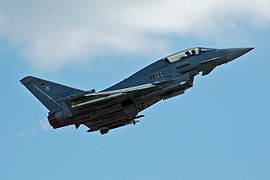
Eurofighter Typhoon
· 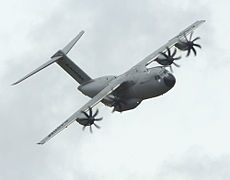
Airbus A400M
· 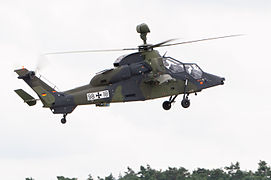
Eurocopter Tiger
CSDP also has some specific institutions: the Political and Security Committee, the Military Committee, the Military Staff, the Committee for Civilian Aspects of Crisis Management, and the EU Civilian and Military Planning Cell. There is also a European Defense Agency with the task of "contributing to the identification of measures to strengthen the industrial and technological base of the defense sector." In principle, decisions can only be taken unanimously in the Council of the EU. The so-called passerelle rule, by which otherwise topics requiring unanimity can be transferred to the area of majority decisions, is also not applicable to CSDP. However, if a group of member states wishes to move forward more quickly in CSDP than others, they have the option of Permanent Structured Cooperation (Art. 46 TEU), which essentially corresponds to enhanced cooperation in other policy areas.
The aim of CSDP is to fulfill the so-called Petersberg tasks, namely humanitarian and rescue missions, peacekeeping tasks and combat missions in crisis management, including peace-building measures. For this purpose, EU states can undertake joint military missions, which was first done in 2003 in Operation Artemis in eastern Congo. According to the text of the treaty, CSDP could also lead to a common European defense, i.e. a European army. However, this would require a unanimous decision by the European Council, which seems unlikely at present - especially because several EU states are also active in NATO, while others are neutral. The member states provide troops for missions within the framework of CSDP, such as the EU peacekeeping mission EUFOR, in each case on a voluntary basis and according to national legal requirements (Germany, for example, only after approval by the Bundestag). The EU Battlegroups, which were set up in 2005 and consist of two multinational combat units of 1,500 soldiers each, are aimed at intensifying practical cooperation within the framework of CSDP and are intended to be ready for deployment at short notice in the event of a crisis. They are provided by a group of member states for six months at a time and then disbanded. However, these supranational units have not actually been deployed since their introduction because of disputes over funding.
At the end of 2017, 25 of the then 28 member states signed an agreement on Permanent Structured Cooperation (PESCO) in defense and security policy, which provides for joint operations and armaments projects as well as a regular increase in defense spending by the participating states. Apart from the United Kingdom, which is dealing with Brexit, the EU members Denmark and Malta have not joined the agreement.
European Neighborhood Policy
→ Main article: European Neighborhood Policy
An important component of European foreign policy is its relations with its immediate neighbors to the south and east of the EU, with whom it has concluded a dense network of agreements since 2004 as part of the European Neighborhood Policy (ENP). The ENP aims to promote economic cooperation on the one hand and to strengthen democracy and the rule of law in the EU's immediate vicinity on the other. In parallel with this neighborhood policy, the Union for the Mediterranean was established in 2008 with the states in North Africa and the Middle East (including Turkey and Israel), following on from the Euro-Mediterranean Partnership of 1995. In 2009, the Eastern Partnership was initiated, the aim of which is the political association and economic integration of former Soviet Union republics.
The ENP is aimed primarily at those states that seek close relations with the EU but cannot join it in the foreseeable future for political or geographical reasons. The ENP therefore does not include the states in the Western Balkans, which are considered potential candidates for accession. These are being prepared for membership in so-called Stabilization and Association Agreements (SAAs). This binds the applicant states more closely to the EU both economically and politically, which should make accession talks easier.
Both the ENP and the negotiations with the accession candidates are not the responsibility of the High Representative for Foreign Affairs and Security Policy, but of the Commissioner for Enlargement of the European Commission. However, he must coordinate closely with the High Representative in order to ensure the coherence of European foreign policy.
Development policy
→ Main article: Development policy of the European Union
The European Union is also active in development policy (Art. 208 ff. TFEU). European states thus bear responsibility, especially in Africa and parts of South America, for the damage caused under their rule during colonization. Unlike foreign and security policy, decisions on development policy measures are taken in accordance with the ordinary legislative procedure, i.e. with the equal participation of the European Parliament.
Among the individual measures, the trade concessions for developing countries through the Generalized System of Preferences, the raw materials regime and, in particular, humanitarian aid through the responsible European office ECHO are worth mentioning. In addition, a number of states are granted additional trade privileges through bilateral or multilateral treaties. The most important of these is the Cotonou Agreement, which was concluded in 2000 with 77 states in the African, Caribbean and Pacific regions (so-called ACP states) and replaced the previous Lomé Conventions. In most cases, these agreements oblige the partner countries to comply with certain democratic and rule-of-law standards in return.
The European Investment Bank also contributes to development policy and, together with the European Development Fund, also provides the bulk of the financial resources.
In the Union for the Mediterranean, the EU promotes the development of the Arab Mediterranean states as well as Turkey and Israel. At the heart of this are bilateral agreements with the individual states which, in addition to extensive exemption from customs duties, provide for further trade concessions and cooperation in the technical and economic spheres.
Justice and home affairs policy
Since the Treaty of Maastricht in 1992, the European Union has had competences in justice and home affairs policy. The third pillar, which was created at that time, contains regulations for cooperation in the areas of justice and home affairs. Matters of common interest are thus asylum policy, rules on crossing the external borders of the Member States, immigration policy, combating illegal immigration, drug addiction and fraud on an international scale, as well as judicial cooperation in civil and criminal matters, police cooperation to combat terrorism, illegal drug trafficking and other serious forms of international crime.
The 1997 Treaty of Amsterdam introduced the broader objective of a Europe-wide area of freedom, security and justice and incorporated the Schengen Agreement on the abolition of checks on persons at internal borders into EU law. This covers border control, asylum and immigration policies (Art. 77 et seq. TFEU, formerly known as flanking measures to the free movement of persons), also judicial cooperation in civil matters (JZZ, Art. 81 TFEU) and police and judicial cooperation in criminal matters (PJZS, Art. 82 ff. TFEU). Through the PJZS, the EU can, among other things, set minimum standards in criminal procedural law, such as the rights of defendants (Art. 82 TFEU). For certain cross-border crimes, such as terrorism, trafficking in human beings, drug trafficking, arms trafficking, money laundering, corruption, and computer crime, it can also regulate minimum rules on criminal offenses and penalties (Art. 83 TFEU).
After the Council initially decided unanimously for all these areas and the European Parliament had no powers, the ordinary legislative procedure was gradually introduced. Since the Treaty of Lisbon in 2007, it has applied to all justice and home affairs policies. However, some Member States, namely the United Kingdom, Ireland and Denmark, have derogations; they participate in the common measures only in a limited way. On the other hand, some non-EU states, namely Iceland, Norway, and Switzerland, have also joined the Schengen Agreement and are therefore required to implement certain decisions taken by the EU within this framework.
To implement the common justice and home affairs policy, the European authorities Europol and Eurojust were established to coordinate the cooperation of national police and judicial authorities. In addition, the Schengen Information System has been established, through which Member States exchange information on persons and objects wanted. For joint border management, there is the European Agency for the Management of Operational Cooperation at the External Borders of the Member States of the European Union (Frontex for short). Measures taken under the PJZS also include the European Arrest Warrant, which facilitated the extradition of criminals between member states.
The establishment of a European Public Prosecutor's Office to fight crimes under Article 86, among others, those detrimental to the financial interests of the Union, has been underway for several years, but despite the approval of the European Parliament, it was not implemented by the European Council until 2016, when it was decided in 2017 to implement it in the initially smaller framework of structured cooperation.
Education policy and research funding
The transformation of European countries from classic industrial societies to potential information and knowledge societies, triggered by technological innovation thrusts and global networking opportunities, has led to significant activities in this area by the EU institutions, which for decades paid little attention to education policy (Art. 165 f. TFEU). For example, the Lisbon Strategy adopted in 2000, as well as its successor program Europe 2020, sees education policy as the most important instrument for promoting the European economy. It aims to create a European education and employment area based on lifelong learning.
The Bologna Process, which was launched in 1999 at a conference of 29 European education ministers and now encompasses 45 countries, is designed to create a European Higher Education Area. It is not limited to the EU, but is oriented toward its educational policy goals. Its core component is a two-tier system of degrees, which in Germany have been called bachelor's and master's degrees, following the Anglo-Saxon model. While the bachelor's degree usually lasts three to four (in Germany three) years and is intended to provide the first degree that qualifies students for a profession, the master's degree lasts one to two (in Germany two) years and is intended for specialization. This can be followed by a doctorate to achieve a doctorate, which is already the highest academic degree in Europe.
In order to promote the free movement and mobility of learners in Europe, the European Qualifications Framework (EQF) was also introduced, a scheme for standardizing qualification requirements within which defined competencies are assigned to specific levels. This system is intended to make educational qualifications more comparable internationally. Specifically for higher education, a Europe-wide credit transfer system (ECTS) was created to facilitate the recognition, transfer and accumulation of credits across Europe, also to facilitate the recognition of study periods abroad and to promote the mobility of students across Europe.
In analogy to higher education, a credit point system is also being developed for vocational training. This is intended to enable individual learners throughout Europe to document their learning success or the skills they have acquired. The points should also be able to be credited anywhere in Europe. The aim is to increase the permeability of the different education systems in Europe, but this requires a restructuring of the education and training programs in the member states.
In addition to these measures to create a common European higher education area, there have already been a large number of EU programs since the 1980s that are intended to promote Europe-wide exchange in education. In July 2004, the European Commission presented a legislative proposal to merge these programs into a single Lifelong Learning Program, structured according to four different educational sectors: general (school) education, vocational education and training, higher education, and adult education. Among the currently existing cooperation measures of a general education nature, the Erasmus higher education program is particularly well known, promoting transnational cooperation and exchanges of students and lecturers. There is also the Comenius program, which supports school partnerships, Lingua, which promotes foreign language teaching at the EU level, and Leonardo, which stimulates corresponding activities in vocational education, as well as the Grundtvig program, which is responsible for adult education. Since 2014, these European education programs have been continued together in a coordinated manner under the umbrella of the Erasmus+ program.
In addition to teaching, the EU is also active in research funding (Art. 179 ff. TFEU). The European Research Council, which was founded by the European Commission and began its work at the beginning of 2007, is intended to support basic scientific research. A total of 22 scientists appointed to the Research Council allocate project funds of initially one billion euros annually, independently of political influence, according to excellence criteria and without regard to regional distribution. In addition to the previously funded thematic programs, there is now also general funding for research without immediate application (so-called frontier research). The program is intended, among other things, to make the EU more attractive as a research location for highly qualified people, to better identify outstanding scientific talent, and to fill personnel gaps in top-level research, initially primarily by supporting young scientists.
Social and employment policy
→ Main article: Social policy of the European Union
Although the harmonization of social standards was one of the goals of the European Economic Community at an early stage, the national reservations of sovereignty and the demand for the principle of subsidiarity are generally more pronounced here than in economic policy. For this reason, the principle of unanimity applies in the Council of the EU in certain issues in this policy field, such as social security; the European Parliament need only be consulted and has no co-determination rights. The importance of national policy-making in these fields is therefore correspondingly more important: The important social security systems, such as unemployment and social assistance, are still located at the level of the nation states. Since they account for a large share of the national budget in all EU member states - and thus also of the scope for policy-making - governments also have little interest in transferring competencies to the EU in this area. In other areas, however, such as occupational safety or gender equality, the ordinary legislative procedure applies.
The EU's social policy (Art. 151 et seq. TFEU) is therefore based in material terms mainly on the European Social Fund, which was established in 1960 and whose resources are used for measures in vocational training, retraining, combating youth unemployment (75% of funding) and reintegrating the unemployed. In addition, the anchoring of fundamental social rights in the EU Treaty is linked to the concern to have a standardizing effect on the social policy of the member states. This is reflected, among other things, in the accentuated EU equality policy in the sense of implementing the gender mainstreaming concept, in anti-discrimination requirements and in requirements for reconciling work and family life.
With the Treaty of Amsterdam, the EU also made an active employment policy its program (Art. 145 ff. TFEU). The funds available for this purpose were initially very small, but have been gradually expanded. The aim is a strategy coordinated between the EU and the member states, which is primarily aimed at improving the qualifications of job seekers and at labor market flexibility. The EU also promotes labor market policy coordination among the member states.
Consumer protection
In 1992, the Maastricht Treaty introduced consumer protection interests into the European treaties for the first time (Art. 12, Art. 169 TFEU). The primary objectives are not only uniform quality standards in production and trade, but also health protection and consumer education and information. This is evident, for example, in the mandatory labeling of genetically modifiedproducts.
Following the deficiencies in consumer protection that became apparent during the cattle epidemic BSE, the Directorate-General for Health and Consumer Protection was set up at the European Commission in 1999, with responsibility for plant protection, veterinary and food controls, among other things. Thus, the free movement of goods in the internal market can be partially suspended by export bans if there is a health risk to consumers from certain products. The Product Liability Directive, introduced as early as 1985, places the burden of proof for a defect-free product on the manufacturer's side in the event of damage, for example in the case of children's toys, textiles and cosmetics. EU consumer policy also covers, for example, refund claims for package tours, misleading advertising and unfair contract terms, especially in cross-border transactions.
Environmental policy
→ Main article: Environmental policy of the European Union
An active environmental protection policy (Art. 191 ff. TFEU) has been pursued by the European Economic Community since the early 1970s, for example in the areas of water protection, air pollution control and waste disposal. While the initial focus was on aftercare environmental protection in the sense of remedying damage that has occurred, the principle of prevention has since been increasingly emphasized. Since the Treaty of Amsterdam, environmental protection has been a cross-cutting principle that must be taken into account in all EU measures. For example, in the planning of economic and infrastructure projects, an environmental impact assessment must be undertaken as a matter of principle, which precedes the approval of construction measures as a uniform administrative procedure.
Legal acts in environmental policy are generally adopted in accordance with the ordinary legislative procedure. Individual states have the option of applying stricter environmental standards than those applicable to the EU as a whole, provided that this does not create barriers to trade.
The Fauna-Flora-Habitat Directive is intended to preserve natural habitats of wild animals and plants and thus biological diversity. Designated protected areas in the EU member states are to develop into a European ecological network (Natura 2000). This network serves to preserve, (re-)establish and develop ecological interrelationships and to promote natural dispersal and recolonization processes. It is thus the central legal instrument of the European Union for implementing the commitments made by the member states, also in 1992, to protect biological diversity (Convention on Biological Diversity, CBD, Rio 1992).
The EU provides financial support to Member States for the designation of Sites of Community Importance (SCI) and Special Protected Areas (SPA). At the end of 2013, there were 27,308 SCI and SPA sites designated, covering 1,039,332 km², 787,767 km² land area, 251,565 km² marine area.
Climate and energy policy
→ Main articles: European Union climate policy and European Union energy policy
In addition to traditional environmental policy, climate protection is also a contractual objective of the EU. Among the major international players, the EU plays a pioneering role in this area, although the commitment and success of individual member states varies. The reduction of carbon dioxide emissions is to be achieved through various measures, above all through EU emissions trading. In addition, the EU is promoting the replacement of fossil fuels with renewable energies through the ALTENER program.
In recent years, climate policy has developed into one of the EU's most dynamic policy areas. In organizational terms, climate policy was for a long time part of the Directorate-General for the Environment. In the Barroso II Commission, the office of a Commissioner for Climate Protection was created for the first time, which now exists independently of the Environment Commission.
The European Union's energy policy has only been institutionalized in the Treaty of Lisbon (Art. 194 TFEU). Isolated energy policy initiatives (to promote energy efficiency or to unbundle energy supply companies) had already been taken beforehand via the detour of environmental or competition policy. The goals of energy policy are a functioning energy market, the guarantee of energy supply, the promotion of energy efficiency and renewable energies, and the interconnection of energy networks between the member states. Measures concerning the choice between different energy sources, i.e. the energy mix of the Member States, can only be taken unanimously according to Art. 192 (Energy Law).
On March 9, 2007, the European Union made a binding commitment to reduce greenhouse gas emissions by one-fifth by 2020 compared with 1990 levels and to increase the share of renewable energies on average to 20% by 2020. In January 2008, the European Commission adopted binding targets for the individual member states. Directive 2009/28/EC obliges the member states to set national indicative targets for the share of renewable energies in electricity consumption, while expressly giving the individual states free rein with regard to the support systems in detail.
In the political guidelines of the new Commission President Jean Claude Juncker, it is planned to reform and restructure Europe's energy policy and to create a European Energy Union with an increased share of renewable energy in the energy mix. The aim is for Europe's energy union to become the world's number one in renewable energies.
Transport and space policy
The EU's transport policy (Art. 90 et seq. TFEU) is primarily aimed at improving the cross-border mobility of people and goods in the internal market. An essential component of this is the establishment and expansion of Trans-European Networks (TENs, Art. 170 TFEU), which are to connect the various European regions by 2020. This TEN project includes roads, railroads, inland waterways, combined transport (linking different modes of transport), ports, airports and transhipment facilities for long-distance freight transport, but also information, navigation and traffic management systems.
In addition, the goal of environmental compatibility also plays an important role in EU transport policy. The European Commission is taking account of the increasing burden on the residential population and the environment resulting from road traffic and aviation with proposals that provide for higher technical environmental standards for vehicles and increasingly charge road and environmental costs to users.
In addition, the Commission is focusing above all on promoting rail transport: As early as 1996, it presented a White Paper on "Revitalizing Europe's Railways," which envisages the formation of so-called trans-European freeways for freight rail transport. In one segment of the TEN development, there are major projects such as the Paris-Brussels-Cologne-Amsterdam-London high-speed line.
Beyond its domestic market-oriented transport policy, the EU also pursues its own space policy in close cooperation with the European Space Agency (ESA), with which the EU has concluded a contract, the EU-ESA Framework Agreement. The European Space Council, formed for this purpose, is responsible for the EU's space policy and coordination with ESA and other partners.
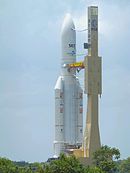
European Space Agency launcher, type Ariane 5 ECA
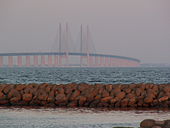
The Øresund Bridge between Denmark and Sweden is part of the Trans-European Networks
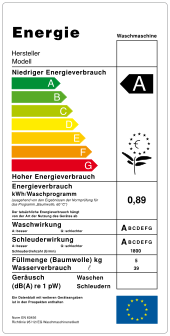
EU energy efficiency label

Erasmus+ , the EU's umbrella program for education, training, youth and sport
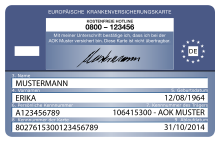
A European Health Insurance Card

The yellow lady's slipper is protected in the EU by the Fauna-Flora-Habitat Directive.
| High Representative for Foreign Affairs and Security Policy Josep Borrell | In the framework of the G8 meetings, the EU/EC has been represented as a participant with observer status since 1977. |

The Bologna Process is designed to create a European Higher Education Area.

Europol headquarters in The Hague

The Schengen area has led to the abolition of border controls. (open "Schengen border" near Kufstein, Tyrol)
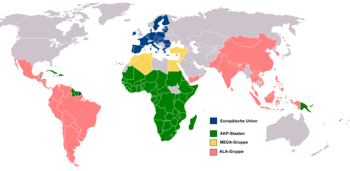
Beneficiary countries of privileged EU development aid
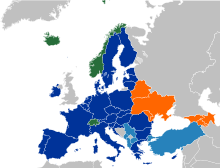
EU Candidate countries EFTA Eastern Partnership

Main building of the European Border and Coast Guard Agency Frontex.
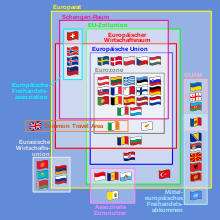
Members of the EU and other European organizations
Typical indication of ERDF support for a construction measure
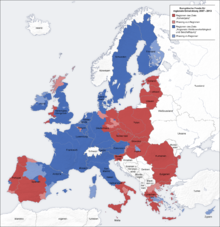
European Regional Development Fund (ERDF) 2007-2013

Competition Commissioner Margrethe Vestager

European Monetary UnionStatus : February 1, 2020 Eurozone members (19) ERM II members with opt-out clause (1: Denmark) Countries applying for ERM II membership (2: Bulgaria, Croatia) Other EU members without opt-out clause (5) Unilateral users of the euro (Montenegro, Kosovo)

Trade Commissioner Valdis Dombrovskis represents the EU in the World Trade Organization.

The European Customs Union consists of the EU (dark blue) and the partner states Turkey, Andorra and San Marino (light blue). There is a free trade zone with the EEA states Iceland, Liechtenstein and Norway.
→ Main article: Economy of the European Union
With a nominal gross domestic product of 14.82 trillion euros (as of 2016), the European Union is the largest single market in the world, generating around a quarter of global GDP. However, per capita income is subject to strong fluctuations depending on the country and is usually significantly higher in northern and western Europe than in the southern and eastern member states. In 2016, it was highest in Luxembourg at 92,900 euros and lowest in Bulgaria at $6,600.
The most important economic sectors are industry and services, while agriculture accounts for only a small part of the European economy. Economic growth in the EU averaged 2.2% between 2000 and 2008. Due to the global financial and economic crisis, the EU experienced a 4.4% recession in 2009. The impact on economic growth and unemployment rates in the EU as a whole is clearly reflected in the relevant statistics, as are the differences among EU member states in this regard. In the two following years, GDP rose again (by 2.1% in 2010, by 1.7% in 2011), and in 2012 it fell again slightly by 0.5%. From 2013, a recovery set in and the economy grew by 0.2%. From 2014, economic output grew by just under 2% a year, returning to the pre-crisis level.
The average annual inflation rate between 2003 and 2013 was 2.25%. The unemployment rate was 7.4% in March 2017, and the energy intensity of the European economy (energy consumption in kilograms of oil equivalents per €1000 of GDP) was 151.6 in 2008 (for comparison: USA 180.7; Japan 90.1).
In terms of foreign trade, the EU achieved a current account surplus of USD 387,100 million in 2016, which was the highest surplus of all economic areas.
Gross Domestic Product
The development of the gross domestic product (purchasing power parity) of the European Union compared with countries outside the EU (IMF data, October 2020).
| GDP (PPP) in billions of international dollars from 2008 to 2019 | |||||||||||||
| '08 | '09 | '10 | '11 | '12 | '13 | '14 | '15 | '16 | '17 | '18 | '19 | ||
| European Union | 16.936 | 16.324 | 16.852 | 17.506 | 17.751 | 18.087 | 18.647 | 19.205 | 20.008 | 20.852 | 22.042 | 20.720 | European Union |
| United States | 14.719 | 14.419 | 14.964 | 15.518 | 16.155 | 16.663 | 17.348 | 17.947 | 18.569 | 19.391 | 20.580 | 21.433 | United States |
| China People's Republic of | 9.967 | 10.967 | 12.279 | 13.717 | 15.046 | 16.468 | 17.961 | 19.392 | 21.292 | 23.159 | 25.279 | 23.393 | China People's Republic |
| Japan Japan | 4.281 | 4.075 | 4.320 | 4.389 | 4.547 | 4.684 | 4.760 | 4.830 | 5.238 | 5.429 | 5.597 | 5.451 | Japan |
| Brazil | 2.559 | 2.576 | 2.803 | 2.973 | 3.086 | 3.231 | 3.287 | 3.192 | 3.141 | 3.240 | 3.366 | 3.223 | Brazil |
| Russia | 3.292 | 3.0572 | 3.2342 | 3.442 | 3.628 | 3.734 | 3.824 | 3.718 | 3.800 | 4.008 | 4.227 | 4.136 | Russia |
| India | 4.355 | 4.760 | 5.312 | 5.782 | 6.219 | 6.740 | 7.347 | 7.965 | 8.662 | 9.459 | 10.485 | 9.542 | India |
Economic development
| GDP Growth Rates of the EU Member States from 2006 to 2016 | |||||||||||||
| Member State | '06 | '07 | '08 | '09 | '10 | '11 | '12 | '13 | '14 | '15 | '16 | 2006–2016 | |
| Belgium | 2,5 | 3,4 | 0,7 | −2,3 | 2,3 | 1,8 | 0,1 | −0,1 | 1,5 | 1,6 | 1,2 | 12,6 | Belgium |
| Bulgaria | 6,9 | 7,3 | 6,0 | −3,6 | 1,3 | 1,9 | 0,0 | 0,9 | 1,3 | 3,6 | 3,4 | 29,0 | Bulgaria |
| Denmark Denmark | 3,9 | 0,9 | −0,5 | −4,9 | 1,9 | 1,3 | 0,2 | 0,9 | 1,7 | 1,6 | 1,3 | 8,3 | Denmark |
| Germany | 3,7 | 3,3 | 1,1 | −5,6 | 4,1 | 3,7 | 0,5 | 0,5 | 1,6 | 1,7 | 1,9 | 16,5 | Germany |
| Estonia | 10,3 | 7,7 | −5,5 | −14,7 | 2,3 | 7,6 | 4,3 | 1,4 | 2,8 | 1,4 | 1,6 | 19,2 | Estonia |
| Finland | 4,1 | 5,2 | 0,7 | −8,3 | 3,0 | 2,6 | −1,4 | −0,8 | −0,6 | 0,3 | 1,4 | 6,2 | Finland |
| France | 2,4 | 2,4 | 0,2 | −2,9 | 2,0 | 2,1 | 0,2 | 0,6 | 0,9 | 1,1 | 1,2 | 10,2 | France |
| Greece | 5,7 | 3,3 | −0,3 | −4,3 | −5,5 | −9,1 | −7,3 | −3,2 | 0,4 | −0,2 | 0,0 | −20,5 | Greece |
| Ireland | 5,9 | 3,8 | −4,4 | −4,6 | 2,0 | 0,0 | −1,1 | 1,1 | 8,5 | 26,3 | 5,2 | 42,7 | Ireland |
| Italy | 2,0 | 1,5 | −1,1 | −5,5 | 1,7 | 0,6 | −2,8 | −1,7 | 0,1 | 0,8 | 0,9 | −3,5 | Italy |
| Croatia | 4,8 | 5,2 | 2,1 | −7,4 | −1,7 | −0,3 | −2,2 | −1,1 | −0,5 | 1,6 | 2,9 | 3,4 | Croatia |
| Latvia | 11,9 | 9,9 | −3,6 | −14,3 | −3,8 | 6,4 | 4,0 | 2,6 | 2,1 | 2,7 | 2,0 | 19,9 | Latvia |
| Lithuania | 7,4 | 11,1 | 2,6 | −14,8 | 1,6 | 6,0 | 3,8 | 3,5 | 3,5 | 1,8 | 2,3 | 25,3 | Lithuania |
| Luxembourg | 5,2 | 8,4 | −1,3 | −4,4 | 4,9 | 2,5 | −0,4 | 4,0 | 5,6 | 4,0 | 4,2 | 32,7 | Luxembourg |
| Malta | 1,8 | 4,0 | 3,3 | −2,5 | 3,5 | 1,4 | 2,6 | 4,5 | 8,3 | 7,4 | 5,0 | 39,3 | Malta |
| Netherlands | 3,5 | 3,7 | 1,7 | −3,8 | 1,4 | 1,7 | −1,1 | −0,2 | 1,4 | 2,0 | 2,2 | 12,5 | Netherlands |
| Austria | 3,4 | 3,6 | 1,5 | −3,8 | 1,9 | 2,8 | 0,7 | 0,1 | 0,6 | 1,0 | 1,5 | 13,3 | Austria |
| Poland | 6,2 | 7,0 | 4,2 | 2,8 | 3,6 | 5,0 | 1,6 | 1,4 | 3,3 | 3,8 | 2,8 | 41,7 | Poland |
| Portugal | 1,4 | 2,4 | 0,0 | −2,9 | 1,9 | −1,3 | −3,2 | −1,4 | 0,9 | 0,6 | 1,4 | −0,2 | Portugal |
| Romania | 8,1 | 6,9 | 8,5 | −7,1 | −0,8 | 1,1 | 0,6 | 3,5 | 3,1 | 3,9 | 4,8 | 32,6 | Romania |
| Sweden | 4,7 | 3,4 | −0,6 | −5,2 | 6,0 | 2,7 | −0,3 | 1,2 | 2,6 | 4,1 | 3,2 | 21,8 | Sweden |
| Spain | 4,2 | 3,8 | 1,1 | −3,6 | 0,0 | −1,0 | −2,9 | −1,7 | 2,4 | 3,2 | 3,2 | 8,7 | Spain |
| Slovakia | 8,5 | 10,8 | 5,6 | −5,4 | 5,0 | 2,8 | 1,7 | 1,5 | 2,6 | 3,8 | 3,3 | 40,2 | Slovakia |
| Slovenia | 5,7 | 6,9 | 3,5 | −7,8 | 1,2 | 0,6 | −2,7 | −1,1 | 3,1 | 2,3 | 2,5 | 14,2 | Slovenia |
| Czech Republic Czech Republic | 6,9 | 5,5 | 2,7 | −4,8 | 2,3 | 2,0 | −0,8 | −0,5 | 2,7 | 4,5 | 2,4 | 22,9 | Czech Republic |
| Hungary | 3,9 | 0,4 | 0,9 | −6,6 | 0,7 | 1,7 | 1,6 | 2,1 | 4,2 | 3,1 | 2,0 | 12,8 | Hungary |
| Cyprus Republic of | 4,5 | 4,8 | 3,9 | −1,8 | 1,3 | 0,4 | −3,2 | −6,0 | −1,5 | 1,7 | 2,8 | 6,9 | Cyprus Republic |
| European Union | 3,3 | 3,1 | 0,4 | −4,4 | 2,1 | 1,7 | −0,5 | 0,2 | 1,6 | 2,2 | 2,1 | 11,8 | European Union |
|
| 3,2 | 3,0 | 0,4 | −4,5 | 2,1 | 1,5 | −0,9 | −0,3 | 1,2 | 2,0 | 2,1 | 9,8 |
|
| Member State | '06 | '07 | '08 | '09 | '10 | '11 | '12 | '13 | '14 | '15 | '16 | 2006–2016 | |
Employment
According to Eurostat's statistical survey, the following picture emerges of the development of unemployment in the European Union compared to the United States and Japan between 2005 and 2018. The effects of the financial crisis from 2007 onwards are clearly visible:
| Unemployment rate in % from 2006 to 2018 | |||||||||||||
| Country | '06 | '08 | '09 | '10 | '11 | '12 | '13 | '14 | '15 | '16 | '17 | '18 | |
| Belgium | 8,3 | 7,0 | 7,9 | 8,3 | 7,0 | 7,3 | 8,3 | 8,5 | 8,5 | 7,8 | 7,1 | 6,0 | Belgium |
| Bulgaria | 9,0 | 5,9 | 6,8 | 10,3 | 11,3 | 12,3 | 13,0 | 11,4 | 9,2 | 7,6 | 6,2 | 5,2 | Bulgaria |
| Denmark Denmark | 3,9 | 3,4 | 6,0 | 7,5 | 7,6 | 7,5 | 7,0 | 6,1 | 6,2 | 6,2 | 5,7 | 5,0 | Denmark |
| Germany | 10,1 | 7,4 | 7,6 | 7,0 | 5,8 | 5,4 | 5,2 | 5,0 | 4,6 | 4,1 | 3,8 | 3,4 | Germany |
| Estonia | 5,9 | 5,5 | 11,4 | 18,5 | 13,1 | 10,6 | 8,8 | 7,7 | 6,2 | 6,8 | 5,8 | 5,4 | Estonia |
| Finland | 7,7 | 6,4 | 8,2 | 8,4 | 7,8 | 7,7 | 8,2 | 8,4 | 9,4 | 8,8 | 8,6 | 7,4 | Finland |
| France | 8,8 | 7,4 | 9,1 | 9,3 | 9,2 | 9,8 | 10,3 | 10,3 | 10,4 | 10,1 | 9,4 | 9,1 | France |
| Greece | 9,0 | 7,8 | 9,6 | 12,7 | 17,9 | 24,5 | 27,2 | 26,5 | 24,9 | 23,6 | 21,5 | 19,3 | Greece |
| Ireland | 4,5 | 6,4 | 12,0 | 13,9 | 14,7 | 14,7 | 13,1 | 11,3 | 9,4 | 8,4 | 6,7 | 5,8 | Ireland |
| Italy | 6,8 | 6,7 | 7,7 | 8,4 | 8,4 | 10,7 | 12,1 | 12,7 | 11,9 | 11,7 | 11,2 | 10,6 | Italy |
| Croatia | 11,6 | 8,7 | 9,2 | 11,8 | 13,7 | 15,8 | 17,4 | 17,2 | 16,1 | 13,3 | 11,2 | 8,5 | Croatia |
| Latvia | 7,0 | 7,7 | 17,5 | 19,5 | 16,2 | 15,0 | 11,9 | 10,8 | 9,9 | 9,6 | 8,7 | 7,4 | Latvia |
| Lithuania | 5,8 | 5,8 | 13,8 | 17,8 | 15,4 | 13,4 | 11,8 | 10,7 | 9,1 | 7,9 | 7,1 | 6,2 | Lithuania |
| Luxembourg | 4,6 | 4,9 | 5,1 | 4,6 | 4,7 | 5,0 | 5,7 | 6,1 | 6,5 | 6,3 | 5,5 | 5,6 | Luxembourg |
| Malta | 6,8 | 5,9 | 6,5 | 7,0 | 6,4 | 6,4 | 6,2 | 6,9 | 5,4 | 4,7 | 4,0 | 3,7 | Malta |
| Netherlands | 5,0 | 3,7 | 4,4 | 5,0 | 5,0 | 5,8 | 7,3 | 7,4 | 6,9 | 6,0 | 4,9 | 3,8 | Netherlands |
| Austria | 5,3 | 4,1 | 5,3 | 4,8 | 4,6 | 4,9 | 5,4 | 5,6 | 5,7 | 6,0 | 5,5 | 4,9 | Austria |
| Poland | 13,9 | 7,1 | 8,1 | 9,7 | 9,7 | 10,1 | 10,3 | 9,0 | 7,5 | 6,2 | 4,9 | 3,9 | Poland |
| Portugal | 8,9 | 8,8 | 10,7 | 12,0 | 12,9 | 15,8 | 16,4 | 4,1 | 12,6 | 11,1 | 9,0 | 7,1 | Portugal |
| Romania | 7,2 | 6,4 | 5,6 | 7,0 | 7,2 | 6,8 | 7,1 | 6,8 | 6,8 | 5,9 | 4,9 | 4,2 | Romania |
| Sweden | 7,1 | 6,2 | 8,3 | 8,6 | 7,8 | 8,0 | 8,0 | 7,9 | 7,4 | 6,9 | 6,7 | 6,3 | Sweden |
| Slovakia | 13,5 | 10,1 | 10,7 | 14,9 | 13,6 | 14,0 | 14,2 | 13,2 | 11,5 | 9,6 | 8,1 | 6,5 | Slovakia |
| Slovenia | 6,0 | 4,4 | 5,9 | 7,3 | 8,2 | 8,9 | 10,1 | 9,7 | 9,0 | 8,0 | 6,6 | 5,1 | Slovenia |
| Spain | 8,5 | 11,3 | 17,9 | 19,4 | 20,6 | 23,9 | 26,1 | 25,2 | 22,1 | 19,6 | 17,2 | 15,3 | Spain |
| Switzerland | 7,1 | 4,4 | 6,7 | 7,3 | 6,7 | 7,0 | 7,0 | 6,1 | 5,1 | 4,0 | 2,9 | 2,2 | Switzerland |
| Hungary | 7,5 | 7,8 | 10,0 | 11,2 | 11,0 | 11,0 | 10,2 | 7,8 | 6,8 | 5,1 | 4,2 | 3,7 | Hungary |
| Cyprus Republic of | 4,6 | 3,7 | 5,4 | 6,3 | 7,9 | 11,9 | 15,9 | 16,1 | 15,0 | 13,1 | 11,1 | 8,4 | Cyprus Republic |
| European Union | 8,2 | 7,0 | 9,0 | 9,6 | 9,7 | 10,5 | 10,9 | 10,2 | 9,4 | 8,5 | 7,6 | 6,8 | European Union |
| United States | 4,6 | 5,8 | 9,3 | 9,6 | 8,9 | 8,1 | 7,4 | 6,2 | 5,3 | 4,9 | 4,4 | 3,9 | United States |
| Japan Japan | 4,1 | 4,0 | 5,1 | 5,0 | 4,6 | 4,3 | 4,0 | 3,6 | 3,4 | 3,1 | 2,8 | 2,4 | Japan |
| Country | '06 | '08 | '09 | '10 | '11 | '12 | '13 | '14 | '15 | '16 | '17 | '18 | |
Domestic trade
In terms of exports and imports, the EU handled almost two-thirds of its total trade in goods within its own borders in 2015. For individual member states, the importance of the single market is even greater.
| Domestic trade of the European Union (2015) | |||||||||
| Country | Imports | Domestic imports | Domestic imports | Exports | Domestic exports | Domestic exports | Total internal trading volume | Total inland trade | |
| Belgium | 338.200 | 62,7 | 212.100 | 358.900 | 71,9 | 258.100 | 470.200 | 8,67 | Belgium |
| Bulgaria | 26.400 | 64,4 | 17.000 | 23.200 | 64,2 | 14.900 | 31.900 | 0,41 | Bulgaria |
| Denmark Denmark | 77.100 | 69,4 | 53.500 | 85.900 | 61,2 | 52.600 | 106.100 | 1,88 | Denmark |
| Germany | 946.400 | 65,7 | 612.600 | 1.198.300 | 57,9 | 693.900 | 1.306.500 | 21,82 | Germany |
| Estonia | 13.100 | 81,7 | 10.700 | 11.600 | 75,0 | 8.700 | 19.400 | 0,27 | Estonia |
| Finland | 54.200 | 72,9 | 39.500 | 53.600 | 58,8 | 31.500 | 71.000 | 1,24 | Finland |
| France | 516.100 | 68,3 | 352.700 | 456.000 | 58,8 | 268.200 | 620.900 | 11,02 | France |
| Greece | 43.600 | 52,8 | 23.000 | 25.800 | 53,9 | 13.900 | 36.900 | 0,69 | Greece |
| Ireland | 64.300 | 67,8 | 43.600 | 108.600 | 53,9 | 58.500 | 102.100 | 1,63 | Ireland |
| Italy | 368.600 | 58,5 | 215.600 | 413.800 | 54,9 | 227.200 | 442.800 | 7,87 | Italy |
| Croatia | 18.400 | 77,7 | 14.300 | 11.600 | 65,5 | 7.600 | 21.900 | 0,23 | Croatia |
| Latvia | 12.900 | 79,8 | 10.300 | 10.900 | 68,8 | 7.500 | 17.800 | 0,23 | Latvia |
| Lithuania | 25.500 | 66,7 | 17.000 | 23.000 | 61,7 | 14.200 | 31.200 | 0,39 | Lithuania |
| Luxembourg | 21.100 | 72,5 | 15.300 | 15.600 | 84,0 | 13.100 | 28.400 | 0,54 | Luxembourg |
| Malta | 5.200 | 65,4 | 1.800 | 2.300 | 43,5 | 1.000 | 2.800 | 0,06 | Malta |
| Netherlands | 455.900 | 45,6 | 208.100 | 511.200 | 75,5 | 386.100 | 594.200 | 10,30 | Netherlands |
| Austria | 139.900 | 76,7 | 107.300 | 137.300 | 70,0 | 96.100 | 203.400 | 3,49 | Austria |
| Poland | 173.600 | 70,1 | 121.700 | 178.700 | 79,2 | 141.600 | 263.300 | 3,68 | Poland |
| Portugal | 60.100 | 76,5 | 46.000 | 49.800 | 72,7 | 36.200 | 82.200 | 1,42 | Portugal |
| Romania | 63.000 | 77,1 | 48.600 | 54.600 | 73,6 | 40.200 | 88.800 | 1,22 | Romania |
| Sweden | 124.000 | 69,8 | 86.600 | 126.100 | 58,4 | 73.700 | 160.300 | 2,87 | Sweden |
| Slovakia | 66.300 | 78,6 | 52.100 | 68.100 | 85,5 | 58.200 | 110.300 | 1,56 | Slovakia |
| Slovenia | 26.800 | 69,8 | 18.700 | 28.800 | 76,0 | 21.900 | 40.600 | 0,62 | Slovenia |
| Spain | 278.800 | 60,2 | 167.900 | 254.000 | 65,0 | 165.100 | 333.000 | 5,24 | Spain |
| Switzerland | 126.600 | 77,1 | 97.600 | 142.600 | 83,4 | 118.900 | 216.500 | 3,11 | Switzerland |
| Hungary | 83.500 | 76,2 | 63.600 | 88.800 | 81,4 | 72.300 | 135.900 | 2,01 | Hungary |
| Cyprus Republic of | 5.000 | 74,0 | 3.700 | 1.600 | 56,3 | 900 | 4.600 | 0,10 | Cyprus Republic |
| European Union | 4.698.600 | 63,1 | 2.963.200 | 4.855.700 | 61,0 | 2.963.200 | --- | 100 | European Union |
Foreign Trade
| Top 20 main trading partners of the European Union (2015) | ||||||||
| Rank | Main trading partner | Imports | Imports | Exports | Exports | Total trading volume | Total trade | |
| European Union Total EU | 1.724.867 | 100 | 1.789.063 | 100 | 3.513.929 | 100 | European Union | |
| 1 | United States | 246.211 | 14,3 | 369.549 | 20,7 | 615.760 | 17,5 | United States |
| 2 | China People's Republic | 350.257 | 20,3 | 170.399 | 9,5 | 520.657 | 14,8 | China People's Republic |
| 3 | Switzerland | 102.299 | 5,9 | 150.833 | 8,4 | 253.132 | 7,2 | Switzerland |
| 4 | Russia | 135.876 | 7,9 | 73.905 | 4,1 | 209.781 | 6,0 | Russia |
| 5 | Turkey | 61.574 | 3,6 | 78.959 | 4,4 | 140.533 | 4,0 | Turkey |
| 6 | Norway | 74.313 | 4,3 | 48.867 | 2,7 | 123.180 | 3,5 | Norway |
| 7 | Japan Japan | 59.726 | 3,5 | 56.572 | 3,2 | 116.298 | 3,3 | Japan |
| 8 | Korea Sud South Korea | 42.327 | 2,5 | 47.882 | 2,7 | 90.209 | 2,6 | Korea Sud |
| 9 | India | 39.449 | 2,3 | 37.919 | 2,1 | 77.368 | 2,2 | India |
| 10 | Brazil | 30.879 | 1,8 | 34.588 | 1,9 | 65.468 | 1,9 | Brazil |
| 11 | Canada | 28.223 | 1,6 | 35.210 | 2,0 | 63.433 | 1,8 | Canada |
| 12 | Saudi Arabia | 21.506 | 1,2 | 40.248 | 2,2 | 61.754 | 1,8 | Saudi Arabia |
| 13 | United Arab Emirates | 9.364 | 0,5 | 48.480 | 2,7 | 57.844 | 1,6 | United Arab Emirates |
| 14 | Mexico | 19.675 | 1,1 | 33.657 | 1,9 | 53.333 | 1,5 | Mexico |
| 15 | Singapore | 18.898 | 1,0 | 29.690 | 1,7 | 48.588 | 1,4 | Singapore |
| 16 | Sud Africa | 19.345 | 1,1 | 25.454 | 1,4 | 44.798 | 1,3 | Sud Africa |
| 17 | Taiwan | 25.487 | 1,5 | 18.456 | 1,0 | 43.943 | 1,3 | Taiwan |
| 18 | Algeria | 20.868 | 1,2 | 22.289 | 1,2 | 43.157 | 1,2 | Algeria |
| 19 | Australia | 9.555 | 0,6 | 31.634 | 1,8 | 41.190 | 1,2 | Australia |
| 20 | Vietnam | 29.958 | 1,7 | 8.438 | 0,5 | 38.396 | 1,1 | Vietnam |
1 excluding Hong Kong, Macao and Taiwan
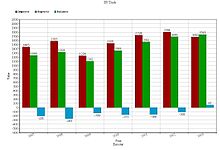
The development of the EU's foreign trade volume (2007-2013)

EU (2015) Top 10 trading partners (2015) Top 11-20 trading partners (2015)
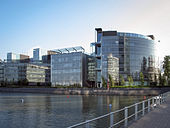
Nokia corporate headquarters in Espoo. 164 companies in the Fortune Global 500 are based in the European Union.

Headquarters of Royal Dutch Shell in The Hague. Largest company in the European Union in terms of sales and profits.
Population
![]()
The articles Demography of the European Union and European Union#Population overlap thematically. Information you are looking for here may also be in the other article.
You are welcome to participate in
the relevant redundancy discussion or to help directly to merge the articles or to better distinguish them from one another (→ instructions).
→ Main article: Demography of the European Union
Based on an estimate by Eurostat, the European Union (EU-28) had 514,117,784 inhabitants living in an area of 4,479,384 square kilometers on January 1, 2019, and 448,285,127 inhabitants living in an area of 4,234,564 square kilometers on January 1, 2020, excluding the United Kingdom (EU-27). This makes the European Union one of the most densely populated regions in the world, with a population density of 119 inhabitants/km² (2019) and 104 ew./km² (2020).
Demographics
The most populous member state is Germany with an estimated population of 83.1 million (2020), the least populous member state is Malta with 514,500 inhabitants. Birth rates in the European Union are very low, averaging around 1.6 children per woman. The highest birth rates are in Ireland, with 16.88 births per thousand inhabitants per year, and France, with 13.01 per thousand inhabitants per year. Germany has the lowest birth rate in the European Union with 8.22 births per thousand inhabitants per year.
| Population and area of the 27 Member States of the European Union | |||||
| Member State | Population | % of the EU | Area | % of the EU | Population density Ew./km² |
| European Union | 448.285.127 | 100 | 4.234.564 | 100 | 106 |
| Belgium | 11.549.888 | 2,58 | 30.510 | 0,72 | 379 |
| Bulgaria | 6.951.482 | 1,55 | 110.912 | 2,62 | 63 |
| Denmark Denmark | 5.816.443 | 1,30 | 43.094 | 1,02 | 135 |
| Germany | 83.100.961 | 18,54 | 357.021 | 8,43 | 233 |
| Estonia | 1.328.976 | 0,30 | 45.226 | 1,07 | 29 |
| Finland | 5.521.292 | 1,23 | 337.030 | 7,96 | 16 |
| France | 67.098.824 | 14,97 | 643.548 | 15,20 | 104 |
| Greece | 10.709.739 | 2,39 | 131.957 | 3,12 | 81 |
| Ireland | 4.964.440 | 1,11 | 70.280 | 1,66 | 71 |
| Italy | 60.897.891 | 13,58 | 301.320 | 7,12 | 202 |
| Croatia | 4.058.165 | 0,91 | 56.594 | 1,34 | 72 |
| Latvia | 1.907.675 | 0,43 | 64.589 | 1,53 | 30 |
| Lithuania | 2.794.090 | 0,62 | 65.200 | 1,54 | 43 |
| Luxembourg | 623.962 | 0,14 | 2.586 | 0,06 | 241 |
| Malta | 514.564 | 0,11 | 316 | 0,01 | 1.628 |
| Netherlands | 17.549.457 | 3,91 | 41.526 | 0,98 | 423 |
| Austria | 8.897.000 | 1,98 | 83.858 | 1,98 | 106 |
| Poland | 37.958.138 | 8,47 | 312.685 | 7,38 | 121 |
| Portugal | 10.295.909 | 2,30 | 92.931 | 2,19 | 111 |
| Romania | 19.317.984 | 4,31 | 238.391 | 5,63 | 81 |
| Sweden | 10.330.000 | 2,30 | 449.964 | 10,63 | 23 |
| Slovakia | 5.457.873 | 1,22 | 48.845 | 1,15 | 112 |
| Slovenia | 2.095.861 | 0,47 | 20.253 | 0,48 | 103 |
| Spain | 47.329.981 | 10,56 | 504.782 | 11,92 | 93,4 |
| Czech Republic Czech Republic | 10.557.001 | 2,35 | 78.866 | 1,86 | 134 |
| Hungary | 9.769.526 | 2,18 | 93.030 | 2,20 | 105 |
| Cyprus Republic of | 888.005 | 0,20 | 9.250 | 0,22 | 96 |
| Member State | Population | % of the EU | Area | % of the EU | Population density Ew./km² |
Cities
→ Main article: List of the largest cities in the European Union
The European Union is home to 15 cities with over a million inhabitants. However, due to the different urban areas, a size comparison is more meaningful for the associated metropolitan regions: With the Paris metropolitan region (aire urbaine de Paris), the largest metropolitan region in the European Union is located in France with approximately 12.5 million inhabitants. However, there are also statistics that work with other spatial delimitations and thus arrive at other population figures and possibly different rankings, such as in the list of the world's largest metropolitan regions, which also includes three metropolitan regions of the EU: Paris, the Ruhr, and Madrid (in that order).
|
| |||||||||||||||||||||
| European Union (Europe) |
| European Union cities with more than one million inhabitants (capitals in bold) | |||||
| # | Name | One resident | Area | Ew. / | Booth |
| 1 | Berlin | 3.644.826 | 892 | 4.090 | Dec. 31, 2018 |
| 2 | Madrid | 3.266.126 | 607 | 5.381 | Jan 1, 2019 |
| 3 | Rome | 2.651.040 | 1.285 | 2.063 | 31 Oct. 2013 |
| 4 | Paris | 2.273.305 | 105 | 21.651 | Jan 1, 2013 |
| 5 | Vienna | 1.889.083 | 415 | 4.257 | Jan 1, 2018 |
| 6 | Bucharest | 1.883.425 | 228 | 8.260 | 20 Oct. 2011 |
| 7 | Hamburg | 1.841.179 | 755 | 2.439 | Dec. 31, 2018 |
| 8 | Budapest | 1.754.000 | 525 | 3.306 | Jan 1, 2015 |
| 9 | Warsaw | 1.794.166 | 518 | 3.464 | Dec. 31, 2020 |
| 10 | Barcelona | 1.636.762 | 100 | 16.368 | Jan 1, 2019 |
| 11 | Munich | 1.471.508 | 310 | 4.747 | Dec. 31, 2018 |
| 12 | Milan | 1.315.416 | 160 | 8.221 | 31 Oct. 2013 |
| 13 | Sofia | 1.301.683 | 492 | 2.646 | Dec. 31, 2012 |
| 14 | Prague | 1.243.201 | 496 | 2.527 | Dec. 31, 2013 |
| 15 | Cologne | 1.085.441 | 405 | 2.584 | Nov. 30, 2020 |
· 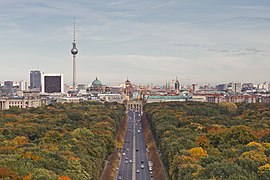
Berlin
· .jpg)
Madrid
· 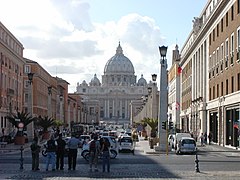
Rome
· 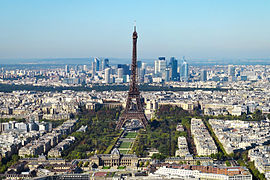
Paris
· 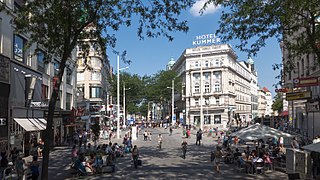
Vienna
· 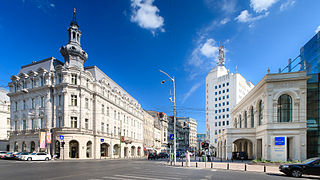
Bucharest
Languages
→ Main article: Official languages of the European Union
In the EU today, 24 languages are recognized as official languages of the European Union with which all EU bodies can be contacted. Most recently, Irish, Bulgarian and Romanian were recognized as additional official languages in 2007, and Croatian in 2013. Of the official languages, English, French and German are used as internal working languages to facilitate communication between the staff of the European institutions. Depending on the institution, one of each of these three working languages has emerged as predominant (for example, English at the ECB). In the European Parliament, speeches can be made in any official language and are simultaneously translated by interpreters. Members of Parliament, journalists and other members of the audience can follow the debates via headphones. MEPs therefore usually speak in their national language, while officials and invited experts often use English or French.
· Language skills in the EU
· 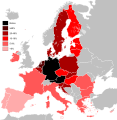
German
· 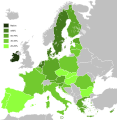
English
· 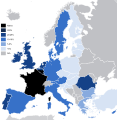
French
The language issue was determined by the first regulation ever issued by the EEC (see below for the text of Regulation 1/1958). The legal basis for the regulation is Art. 342 TFEU:
"The rules governing the languages of the institutions of the Union shall, without prejudice to the Statute of the Court of Justice of the European Union, be determined by the Council, acting unanimously by means of regulations."
According to Art. 24 TFEU, all citizens of the Union have the right to address the institutions of the EU in one of the 24 languages mentioned in Art. 55 TEU and to receive a reply in the same language. In addition to these official languages, there are numerous minority languages, such as Catalan or Basque in Spain or Russian in the Baltic countries. The EU declares that it respects and respects languages and linguistic diversity.
In addition, other programs exist, such as the European Bureau for Lesser-Used Languages (EBLUL) since 1982 and the Mercator Information and Documentation Network since 1987, for the promotion of regional or minority cultures. The EU attaches declared importance to respecting languages and linguistic diversity, i.e. also minority languages in the European Union.
| The six most widely spoken languages in the European Union in 2005 | ||||
| Language | Official language in Member State | Spoken as native language (share of population) | Spoken as a foreign language (share of population) | Total speakers in the EU (share of population) |
| German | Germany | 18 % | 14 % | 32 % |
| English1 | United Kingdom | 13 % | 38 % | 51 % |
| French | France | 14 % | 14 % | 28 % |
| Italian | Italy | 13 % | 03 % | 16 % |
| Spanish | Spain | 09 % | 06 % | 15 % |
| Polish | Poland | 09 % | 01 % | 10 % |
| 1: With the departure of the United Kingdom, the proportion of the population in the European Union whose mother tongue is English has fallen considerably, so the ranking is no longer up-to-date. | ||||
Religions and worldviews
Christianity is the predominant religion in most EU states. Catholicism dominates in the southern member states, Protestantism in the north. Greece, Cyprus, Romania and Bulgaria are Orthodox countries. Possible candidates for membership with predominantly Muslim populations are Albania and Bosnia andHerzegovina. Meanwhile, about a quarter of EU citizens do not belong to any religion.
· Eurobarometer survey of the year 2005
· 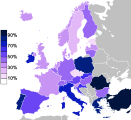
Belief in one God
· 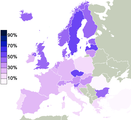
Belief in a kind of supernaturalism
· 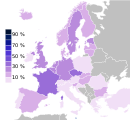
Agnostic or atheist
| Religion in the European Union (2015) | |
| Religion / Worldview | Population share |
| Christianity | 71,6 % |
| - Roman Catholic | 45,3 % |
| - protestant | 11,1 % |
| - orthodox | 9,6 % |
| - other Christian denomination | 5,6 % |
| other religion | 4,5 % |
| - muslim | 1,8 % |
| - buddhist | 0,4 % |
| - jewish | 0,3 % |
| - Hindu | 0,3 % |
| - Sikhist | 0,1 % |
| - Other religions | 1,6 % |
| No religion | 24,0 % |
| - non-believer/agnosticism | 13,6 % |
| - Atheism | 10,4 % |
Living conditions
The United Nations Development Programme classifies all member states as having "very high human development" as all have a 2019 Human DevelopmentIndex (HDI) of more than 0.8. The 2019 HDI is highest for Ireland at 0.955 and lowest for Bulgaria at 0.816.
See also: Table showing the HDI of the Member States: Human Development Index' section in Demography of the European Union.
Health
According to Eurostat data, the average life expectancy at birth for the EU in 2016 was 81 years. For men, it was 78.2 years and for women 83.3 years. Life expectancy in the European Union was thus more than ten years above the global average of just under 70 years. On average, EU citizens in Spain had the longest life expectancy at 83.5 years, while citizens of Lithuania, Bulgaria and Latvia had the shortest within the EU at 74.9 years each. High life expectancies exist above all in southern European countries, although these are not necessarily among the richest countries in the Union; the lower ranks in this respect are all occupied by eastern European countries.
| Rank | State | Life expectancy | ||
| Total | Men | Women | ||
| 1 | Spain | 83,5 | 80,5 | 86,3 |
| 2 | Italy | 83,4 | 81,0 | 85,6 |
| 3 | Cyprus Republic of | 82,7 | 80,5 | 84,9 |
| 4 | France | 82,7 | 79,5 | 85,7 |
| 5 | Luxembourg | 82,7 | 80,1 | 85,4 |
| 6 | Malta | 82,6 | 80,6 | 84,4 |
| 7 | Sweden | 82,4 | 80,6 | 84,1 |
| 8 | Austria | 81,8 | 79,3 | 84,1 |
| 9 | Ireland | 81,8 | 79,9 | 83,6 |
| 10 | Netherlands | 81,7 | 80,0 | 83,2 |
| 11 | Belgium | 81,5 | 79,0 | 84,0 |
| 12 | Greece | 81,5 | 78,9 | 84,0 |
| 13 | Finland | 81,5 | 78,6 | 84,4 |
| 14 | Portugal | 81,3 | 78,1 | 84,3 |
| 15 | Slovenia | 81,2 | 78,2 | 84,3 |
| 16 | United Kingdom | 81,2 | 79,4 | 83,0 |
| 17 | Germany | 81,0 | 78,6 | 83,5 |
| - | Europe | 81,0 | 78,2 | 83,6 |
| 18 | Denmark Denmark | 80,9 | 79,0 | 82,8 |
| 19 | Czech Republic Czech Republic | 79,1 | 76,1 | 82,1 |
| 20 | Croatia | 78,2 | 75,0 | 81,3 |
| 21 | Estonia | 78,0 | 73,3 | 82,2 |
| 22 | Poland | 78,0 | 73,9 | 82,0 |
| 23 | Slovakia | 77,3 | 73,8 | 80,7 |
| 24 | Hungary | 76,2 | 72,6 | 79,7 |
| 25 | Romania | 75,3 | 71,7 | 79,1 |
| 26 | Bulgaria | 74,9 | 71,3 | 78,5 |
| 27 | Lithuania | 74,9 | 69,5 | 80,1 |
| 28 | Latvia | 74,9 | 69,8 | 79,6 |
| Rank | State | Total | Men | Women |
| Life expectancy | ||||
.JPG)
Irish schoolchildren. Ireland has the highest birth rate in the EU with 16.88 births per thousand inhabitants.
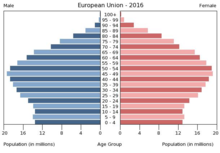
EU population pyramid 2016

Map of EU NUTS 2 areas by population density from 2014.
Culture
With its common cultural policy, the EU aims to "contribute to the flowering of the cultures of the Member States, while respecting their national and regional diversity and at the same time bringing the common cultural heritage to the fore" (Art. 167 TFEU). The goal of cultural cooperation between the EU Member States is often summarized under the catchword of the European cultural area.
The expression of the EU's cultural commitment in the years 1996 to 1999 were the Kaleidoscope (promotion of artistic and cultural activities), Ariane (promotion of the field of books, reading and translation) and Raphael (promotion of cultural heritage of European significance) programs. From 2000 to 2004, a total of 167 million euros was spent on projects aimed at a common cultural area under the successor program Culture 2000. Culture 2000 was extended for two years in 2004 and was then replaced by the 2007-2013 cultural funding program. The bulk of EU funding for culture of about 80% comes from the EU Structural Funds, but accounts for only about 3% of all Structural Funds.
A special accent is set by the European Capital of Culture campaign. Since 1985, this title has been awarded annually to one or two European cities that host numerous cultural events in the corresponding year. The cities thus awarded enjoy increased attention. In 2020, the cities of Galway (Ireland) and Rijeka (Croatia) hold this status.
See also: List of European Capitals of Culture
The European Film Awards are presented annually in over 20 categories. Since 1997, films nominated there have been supported by EU funds from the MEDIA program, among others.
Symbols
→ Main article: Symbols of the European Union
The symbols of the European Union correspond functionally to the emblems and other symbols of nation states. They are intended to reflect the policy of the European Union as a community of nation states. These symbols include the European flag, the European anthem, Europe Day, the European motto and the euro currency.
European flag
The European flag shows a wreath of twelve golden five-pointed stars on an azure background. Their number does not symbolize the number of member states, but is supposed to express "perfection, completeness and unity". The flag has been used as an official emblem by the Council of Europe since 1955, and by the EC since 1985.
European anthem
The European Anthem is the instrumental version of the last movement of the 9th Symphony by Ludwig van Beethoven. In 1972 the melody was adopted as an anthem by the Council of Europe, and in 1985 by the EC. It joins the national anthems of the member states and symbolizes the values shared by all and unity in diversity.
Europe Day
Europe Day is intended to commemorate, through events and publicity, the Schuman Plan of May 9, 1950, which is now considered the cornerstone of European unification. At the Milan Council in 1985, it was decided to commemorate this event annually with the European Union's Europe Day, on which numerous events and festivities have now been held since 1986. In addition, the Council of Europe has celebrated its own Europe Day since 1964: however, this is four days earlier and commemorates the founding of this institution on May 5, 1949.
Europe motto
The European motto is the motto United in diversity, which is intended to express the common, but nationally different European identity. It was chosen in 2000 in the course of a competition among students from 15 European countries.
Sports
It was not until the European Year of Education through Sport (2004) that the EU began to address sport. UEFA had always argued that sport was outside the EU's competence. Through the Bosman decision in 1995, the ECJ made it clear that professional sport is part of the economy, and that the European treaties therefore apply. During a hearing in 2006, it was stated that the organization of national soccer leagues was contrary to the European treaties, as the different sizes of national markets impaired the development of soccer clubs. If, for example, Ajax Amsterdam wanted to play in the Bundesliga, this was perfectly compatible with European law.
The EU's 2007 Weiss Book on Sport lists the problems created by the end of the amateur status (top-level sport is thus generally an economic asset); nevertheless, it continues to be treated as amateur sport under § 165 of the Lisbon Treaty. Although EU funds are now allocated to sport (mobility, integration of foreigners, health prophylaxis, etc.), there is as yet no dedicated EU sports policy.
In the Ryder Cup, the team composed of Europeans currently competes under the EU flag. However, in other competitions where a team Europe competes, this refers more to the continent, not the EU.
Identity
→ Main article: European identity
From the beginning of the 1980s, the European Commission and governments also endeavored to achieve a higher level of active popular support for the unification process. Thus, based on the Adonnino Report on a "Citizens' Europe," which was adopted by the European Council in 1985, a large number of partly symbolic, partly political measures were implemented to make the European Community tangible in everyday life and to promote a common European identity. These ranged from the EU symbols to the European driver's license, the Erasmus student exchange program, European citizenship, the creation of a European Ombudsman and the individual right to petition the European Parliament to EU-wide local elections in the respective place of residence. The Schengen Agreement, which dispenses with controls on the movement of people across borders in a large part of the EU, and the euro as a common currency also play a major role.
To what extent this can help a sense of European identity remains to be seen. Although the majority of the European population is basically positive about their country's membership in the EU, they are somewhat more skeptical about the EU's institutions. This skepticism results from the fact that traditionally it is not the EU but the nation-state that represents the political orientation framework for Europeans, in which citizens articulate their interests. Media, educational systems and political, economic and social interest groups are primarily organized at the national level. Attempts to extend such structures to the European level are proving difficult. In addition to different cultural traditions, it is primarily the language barrier that excludes large parts of the population from corresponding participation and hinders the formation of a European public sphere.
.jpg)
Young EU citizens in the framework of the Erasmus program in Groningen
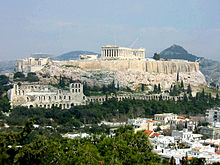
The first European Capital of Culture became Athens in 1985
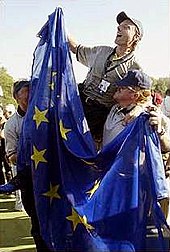
Winning the Ryder Cup in 2006
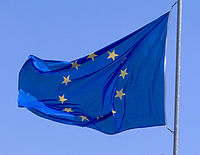
Flag of the European Union

The European Film Academy
Crises and prospects
→ Main article: European integration and democratic deficit of the European Union
→ Main article: EU finality debate and Macron's initiative for Europe
The unique mixture of supranational and intergovernmental structural features of the EU association of states and its organs has been and continues to be the subject of a variety of criticisms, on the one hand, and of different perspectives for the future development of the European Union, on the other. A recurring theme of both criticism and institutional reform is a democratic deficit in the EU's representative and decision-making bodies, which has been countered in past developments by, among other things, strengthening the position of the European Parliament and creating a European citizenship.
The euro crisis triggered by the financial crisis from 2007 onward and the refugee crisis from 2015 onward have boosted the spread of EU skepticism. According to Eurostat, around 15 percent of respondents had a negative image of the EU in 2007; by 2013, this figure had risen to 28 percent. No member state is completely exempt from the negative trend. The sharpest declines were in Greece (from 47 to 16 percent), Portugal (from 55 to 22 percent), Spain (from 59 to 26 percent) and Italy (from 49 to 26 percent). The decline in approval of the EU among sections of the European public goes hand in hand with the strengthening of right-wing populist currents and parties. However, this is not primarily the case (apart from Greece) in the member states most affected by the debt crisis; rather, increases in this regard were observed in the 2014 European elections specifically in France (Front National), the United Kingdom (UK Independence Party) and Denmark (Dansk Folkeparti).
Populists and Euroskeptics achieve success by portraying European policy as the cause of those national problems that are perceived by the population as being of central importance and that are to a not inconsiderable extent of their own making: Economically, the EU is held responsible for distributional injustices within society and for escalating conflicts among the members of the euro zone. Culturally, it is associated with uncontrolled immigration and seen as a threat to national independence. Politically, it is accused of democratic and constitutional deficits. The political scientist Zielonka sees in the integration process of the European Union both elements of a centralized state in the sense of the Westphalian system and those of a polycentric neo-medieval empire, as the Holy Roman Empire had been.
Especially with the Brexit referendum of 2016, the process of continued European integration has clearly stalled. In the EU finality debate, Churchill's vision of a United States of Europe has again been contrasted with a Europe of fatherlands in the sense of de Gaulle. France's President Emmanuel Macron aims to revive EU integration efforts under the impact of the crisis in his widely acclaimed speech at the Sorbonne on September 26, 2017. Among other things, Macron seeks a mild transfer union and a common European Union budget to finance infrastructure and development measures in the EU.
In terms of the economic convergence of the Union, Germany's pronounced trade surplus vis-à-vis the other EU member states is problematic. One of the main reasons cited for the steadily rising trade surplus is that all eurozone members except Germany have increased wages by quotas in recent decades, as suggested by the European Central Bank, while wages in Germany have often not even been increased by productivity growth, with the result that Germany has become a low-wage country in some areas, measured in terms of unit labor costs.
The Corona crisis in spring 2020 is seen as a multifaceted test for the EU. Border controls and border closures between diverse member states stand in the way of free movement. Shortages of intensive care capacity and infection control clothing have fueled national egoisms and mutual competition among EU member states on the global market. Distressed national budgets, especially in southern member states, as a result of the shutdown of all public life, including most sectors of the economy, to reduce infection risks raise questions about effective Community financial assistance and become a touchstone for European Union solidarity and cohesion. The President of the European Commission, Ursula von der Leyen, sees the Corona pandemic as adding a third focus to the two current priorities in the EU's political orientation, climate protection policy and digitization: medical preparedness.
See also
![]()
Portal: European Union - Overview of Wikipedia content related to the topic European Union
- List of Governments of the States of the European Union
Questions and Answers
Q: What is the European Union?
A: The European Union (EU) is a confederation of 27 member countries in Europe established by the Maastricht Treaty in 1992-1993. It has created a common economic area with Europe-wide laws allowing citizens of EU countries to move and trade in other EU countries almost the same as they do on their own.
Q: When was the European Economic Community (EEC) established?
A: The EEC was established by the Treaties of Rome in 1957.
Q: What is the Treaty of Lisbon?
A: The Treaty of Lisbon is the most recent treaty that says how the Union is run. Every member state signed to say that they each agreed with what it says, and it outlines which jobs (’powers’) should be done by the Union and which should be done by individual members.
Q: Where does the name "Europe" come from?
A: The name "Europe" comes from Latin Europa, which derives from Greek Εὐρώπη, from εὐρύς eurys "wide" and ὤψ ops "face".
Q: What are some objectives of EU membership?
A: Some objectives of EU membership include bringing its member states closer together with respect for human rights and democracy, establishing common rules about fair trading between members, creating common agreements about law enforcement, having a common style for passports, and sharing a common currency (the euro).
Q: Do people need to show passports when traveling between EU countries?
A: Most members allow people to travel from one country to another without having to show a passport.
Q: How do members decide how the Union should act?
A: Members decide how the Union should act by voting for or against proposals.
Search within the encyclopedia
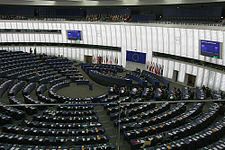

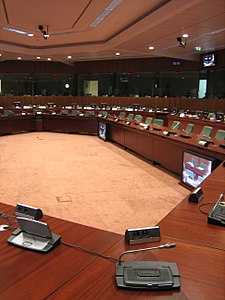
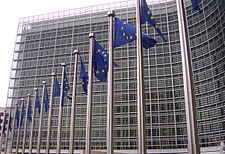
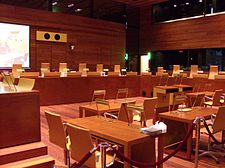
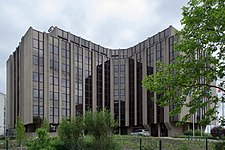
.jpg)
_2019.07.16._Ursula_von_der_Leyen_presents_her_vision_to_MEPs_2_(cropped).jpg)
_Hearing_of_Frans_Timmermans_(the_Netherlands)_-_Executive_Vice_President-Designate_-_European_Green_Deal_(48866429362)_(cropped).jpg)
_Hearings_of_Margrethe_Vestager_DK,_vice_president-designate_for_a_Europe_fit_for_the_digital_age_(48865071413)_(cropped).jpg)
_Hearing_with_Valdis_Dombrovskis,_vice_president-designate_for_an_economy_that_works_for_people_(48864282377)_(cropped).jpg)
_Hearing_of_Josep_Borrell,_High_Representative_Vice_President-designate,_A_stronger_Europe_in_the_World_(48859228793)_(cropped).jpg)
_Informal_JHA_meeting_(Justice)_Press_conference_(39198442504)_(cropped).jpg)
_(cropped).jpg)
._Energy_Ministers_press_conference_(36950060020)_(cropped).jpg)
.jpg)
_A23A0071_(48098290807)_(cropped).jpg)
_(cropped).jpg)
.jpg)
_-_Health_(48828012607)_(cropped).jpg)
.jpg)
_-_International_partnerships_(48825497106)_(cropped).jpg)
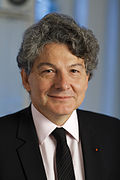
_-_Designate_-_Neighbourhood_and_Enlargement_(49063520601)_(cropped).jpg)
._Arrivals_Phil_Hogan_(37038231115)_(cropped).jpg)
.jpg)
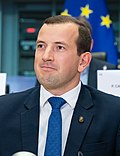

,_candidate_commissioner_for_equality_(48832245446)_(cropped).jpg)
_-_Agriculture_(48826794617)_(cropped).jpg)
_(cropped).jpg)
-_Commissioner_Designate_-_European_Green_Deal_(49063874993)_(cropped).jpg)
_-_Crisis_management_(48833246092)_(cropped).jpg)
_Home_affairs_(48826433018)_(cropped).jpg)
